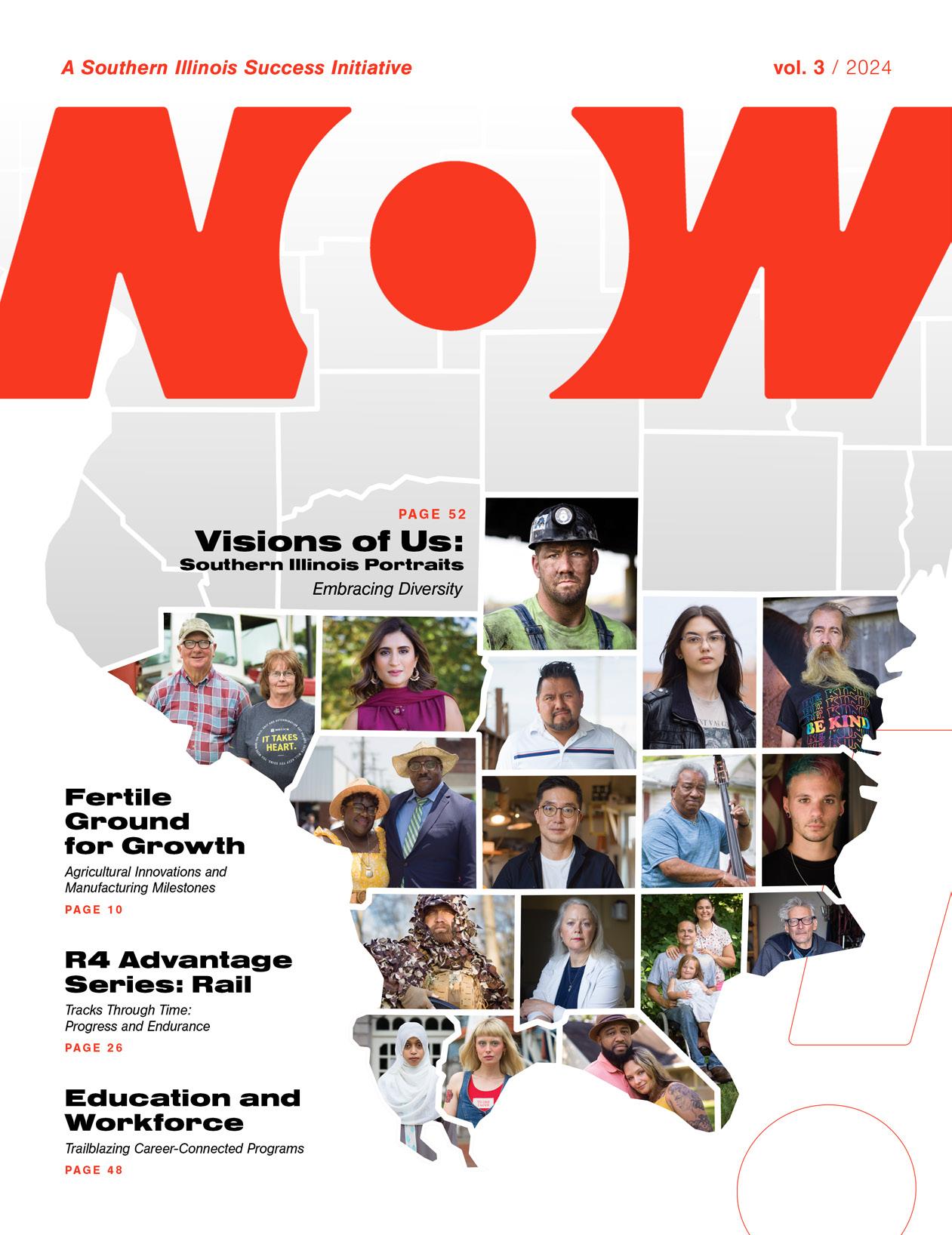

Mission in Motion
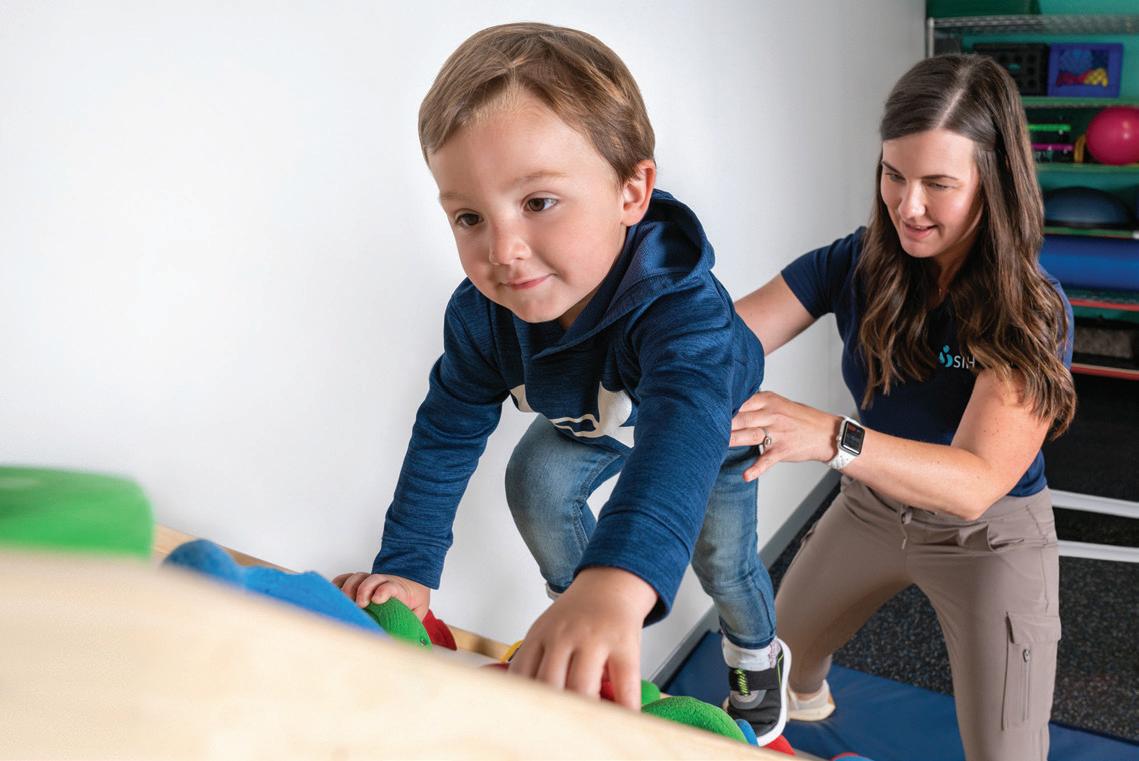
At SIH, mission is central to our culture. Our dedication to provide care to all people in the communities we serve goes beyond the walls of our facilities into at-risk neighborhoods, schools, faith communities, business, industry and so much more.
Big Numbers. Bigger Impact.
Behind each number is a person: a family member, friend, neighbor, colleague.
SIH at a Glance
» 4 Hospitals
» 30+ Clinics
Report to the Community
We’re honored to unveil this online flipbook, featuring short videos, photos and highlights celebrating patient triumphs, nationally recognized services and direct investments in our communities.
Scan the QR code or visit sih.net/MissionInMotion to see how we’re celebrating our commitment to care.
» 4,000+ Employees
» 2,137 Births
» 378 Licensed Beds
» 670+ Medical staff with 60 Specialties and Subspecialties
» 11,044 Surgeries
» 1,240 Special Care Nursery Patient Days
» 230,680 Primary Care Clinic Visits
» 83,241 ED Visits




FExecutive DIRECTOR’S LETTER
all is one my favorite times of the year in Southern Illinois. The rolling hills dotted with shades of red, orange, and yellow provide the perfect backdrop for a weekend hike, a biking adventure along one of the region’s many paths, a visit to your favorite winery along the Shawnee Hills Wine Trail or taking in a fall event with friends on a crisp, cool day.
Fall is also a time of harvest when the hum of farm equipment signals the close of a growing season. Whether it is corn, soybeans, pumpkins, or even horseradish, Illinois is a leading agricultural producer in the country. In this issue, we highlight the region’s fertile ground for agriculture and so much more.
With innovation at the core, agriculture is driving precision technology, fermentation science, entrepreneurship and even energy solutions in Southern Illinois. Our manufacturing sector is also experiencing significant growth with our central location, logistics assets, and lower costs providing strategic supply chain solutions and an overall competitive advantage
Of course, long-standing companies like Gilster-Mary Lee and Continental Tire understand what makes Southern Illinois special as evidenced by their decade’s long success in the region. And with strong workforce and education partners, facilities like the new Southern Illinois Manufacturing Academy at Rend Lake College and envisioned Regional Cultural and Vocational Center in Vienna will ensure a strong talent pipeline for years to come.
As we continue our R4 Advantage series, this issue focuses on our uniquely abundant rail assets. Intersecting every part of the region,
rail is an integral part of what we refer to as our R4 advantage: rivers, rail, roads, and runways. Each one plays a pivotal role in moving passengers and products throughout Southern Illinois, across the country, and around the world. From Mounds to Mt. Vernon, this issue of NOW! shares stories of rail-related companies making an impact on their communities while providing innovative solutions for the customers they serve.
In this issue, you’ll also see how the housing industry is being revolutionized with Cairo, Illinois ahead of the curve with the FIRST 3D printed home in the state. You’ll learn how healthcare in Southern Illinois is leading the way with cutting-edge robotics technology contributing to the region’s outstanding care of its residents.
Of the many things we can be proud of in Southern Illinois, it all comes down to our biggest point of pride: our people. In these pages, you’ll get a glimpse not only into the region’s innovative spirit, industry growth, and upward trajectory, but you’ll see the people who call Southern Illinois home. Whether they are lifelong residents, SIU students who fell in love with the region and stayed, or those who found the region’s opportunities and beauty irresistible, you’ll get a glimpse into the diverse masterpiece that Paul Elledge beautifully portrays as Visions of Us.
NOW! magazine tells the collective story of Southern Illinois as a region that has an impressive history and an even brighter future. Enjoy, share, and spread the good!
Deb Barnett, Ph.D. Executive Director, Southern Illinois Now

SOUTHERN ILLINOIS NOW
Where it all began – from vision to impact.
Regional initiatives are not new in Southern Illinois. The region’s history and successes are a result of strong relationships and strategic collaborations. In fact, as part of the initial conversations about the need for a regional organization like SI Now, stakeholders conducted an assessment resulting in a business case titled Guiding Economic Transformation to Sustained Prosperity (available at https://southernillinoisnow.org/about/).
A deep dive into the history of regional initiatives resulted in a number of successes including SI EDGE (1994) to bring growth and expansion to Southern Illinois, and ConnectSI (2006-2013) focused on advancing Southern Illinois’ broadband access. Key takeaways were documented as a way of building on successes and learning from barriers.
In 2017, the need for a regional marketing strategy was identified. This work later became the SI Works initiative with partnerships from Greater Egypt Regional Planning and Development Commission, Man-Tra-Con, the Southern Illinois Workforce Development Board, the U.S. Economic Development Administration, and the Delta Regional Authority.
At the same time, Southern Illinois University Carbondale (SIU) Chancellor Dr. Carlo Montemagno recognized the need to further strengthen the critical symbiotic relationship between SIU and the region. As a result, in August 2017, Montemagno established the Business Leaders Roundtable and brought together twenty business owners, economic development professionals, regional elected officials, and SIU leaders to identify both key issues
affecting SIU and impediments to regional and individual business growth.
Following Dr. Montemagno’s untimely passing in 2018, Southern Illinois Healthcare (SIH) recognized the importance of building upon the Roundtable’s momentum and brought together these leaders, as well as others from throughout Southern Illinois to launch the Bridge to the Future initiative. SI Bridge to the Future was created in 2018 as a regional leadership group consisting of business leaders, community leaders, elected officials, and others to create regional growth and retention strategies through real-world solutions for the southernmost counties of Illinois. These leaders were successful in creating a platform for regional collaborative economic development and laying out a foundation and vision for the success of our region.
SI Now Today

Today, SI Now is directed by a stellar Board of Trustees driven by regional leaders representing business and industry, education, healthcare, and workforce. In addition, the organization is led by a talented team of professionals with a passion for the region’s growth and aligned with a vast network of partners throughout Southern Illinois who work collaboratively to accomplish the region’s goals while not duplicating efforts.
SI Now is the regional economic development hub promoting the 17 southernmost Illinois counties as a great place to live, work, and do business. We’re uniquely positioned in Southern Illinois – geographically in the middle of the country with a skilled workforce, low cost of living and high quality of life – the perfect place to relocate or start a business. We connect interested companies and people with opportunities and resources.
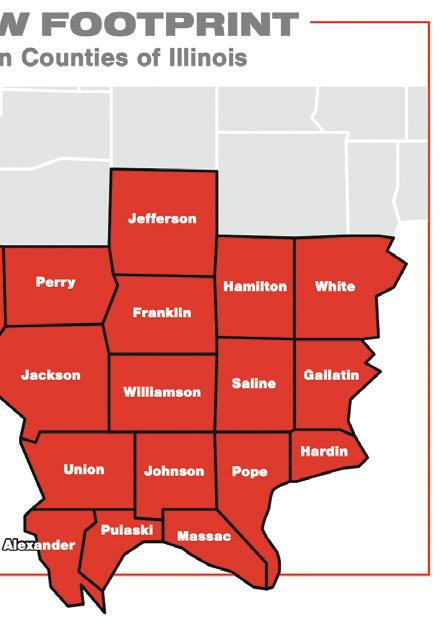
SI Now further unites the region and its collective voice through three task forces designed to support its priority focus areas of business growth and development, education and workforce development, and marketing the region. As a result, the organization benefits from the expertise and diverse perspectives of nearly 100 of the region’s business and economic development leaders.
In the short time since its official launch as a 501(c)(3) organization in November 2022, SI Now has earned the trust and respect of colleagues throughout the 17-county region and the State of Illinois. In its first year, SI Now’s progress established a strong pipeline for upcoming growth. In August 2024, SI Now received two highly esteemed awards of excellence from the International Economic Development Council (IEDC), the largest organization of its kind. The awards highlighted SI Now’s excellence in regional partnerships and telling the region’s collective story through this magazine – NOW!

Southern Illinois Now, visit southernillinoisnow.org
Board of Trustees
KEVIN BECKEMEYER President and CEO Legence Bank
RODNEY CABANESS Co-Owner Black Diamond Harley-Davidson
JOHN DOSIER President and CEO First Southern Bank
STEVE FALAT
General Manager, Market Manager River Radio
DALE FOWLER
State Senator Illinois 59th District
TONY IRITI Executive Director Jefferson County Development Corporation
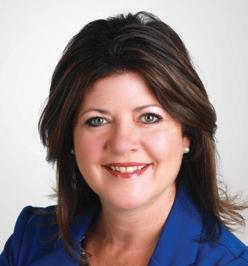
DEBORAH BARNETT, Ph.D. Executive Director
AUSTIN LANE Chancellor Southern Illinois University
LYNN ANDERSEN LINDBERG Executive Director Southern Illinois University Research Park
KATHY LIVELY CEO (Retired) Man-Tra-Con Corporation
ROBERT J. MAY President and CEO Banterra Bank
CARY MINNIS Executive Director Greater Egypt Regional Planning & Development Commission
MIKE MONCHINO Principal Member Monchino Management

NICK HOLDINGHAUSEN Regional Development & Marketing
WILL STEPHENS
Mayor City of Murpysboro
WOODY THORNE
Chief Development Executive - Community Affairs
Southern Illinois Healthcare
MICHAEL TISON Tison Wealth Management
TOM WELGE
President Gilster-Mary Lee
PATRICK WINDHORST
State Representative Illinois 118th District & Board President of One Shawnee

TRICIA EDWARDS Administrative Assistant
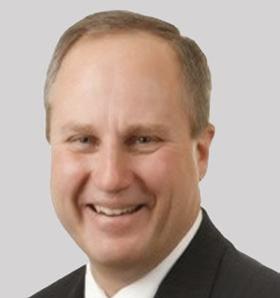

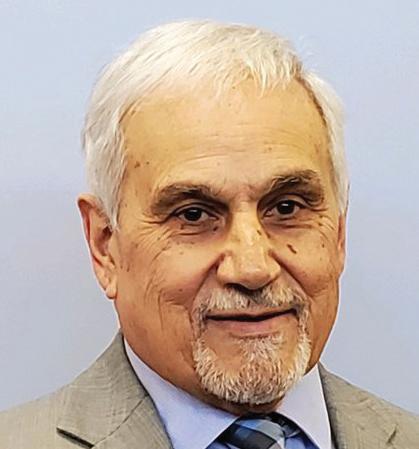


About SI Now
SI Now serves as a regional economic development hub and unified voice for the 17 southern counties of Illinois to advance our region as a great place to live, work, and do business.

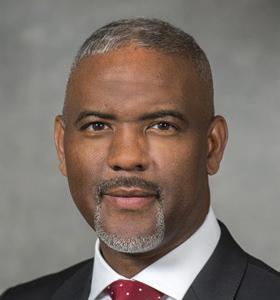



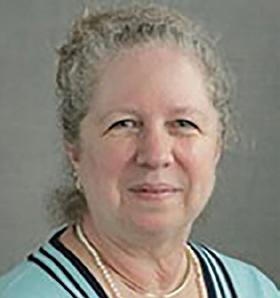
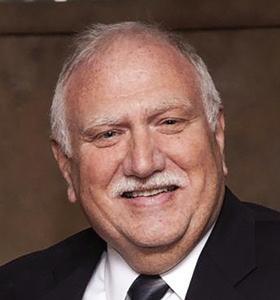
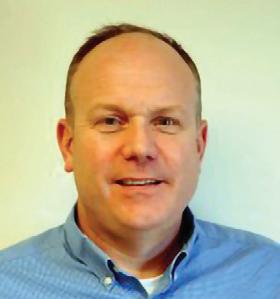
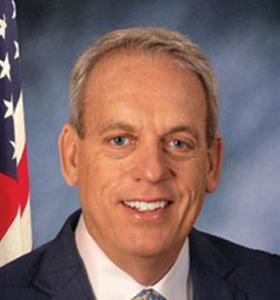

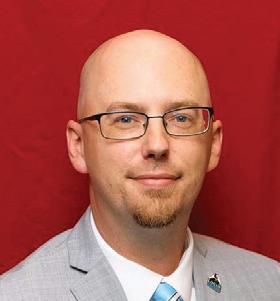


Harvesting:
FERTILE GROUND FOR GROWTH: STEWARD OF THE LAND
The concept of stewardship is ingrained in the ethos of Southern Illinois’ farmers. It’s a commitment to preserving the land’s health and productivity, not just for the present but for the future. By adopting sustainable practices, these farmers are not only securing their livelihoods but also contributing to the ecological balance of the region.
Southern Illinois is a region deeply rooted in agricultural traditions, with its fertile lands and favorable climate making it an ideal location for farming. The area’s agricultural industry is diverse, encompassing everything from traditional row crops like corn and soybeans to specialty crops such as fruits and vegetables. This diversity not only supports the local economy but also contributes to the region’s cultural richness.
The presence of renowned institutions like Southern Illinois University (SIU) Carbondale further bolsters agriculture by providing cutting-edge research and education that drive innovation in
farming practices. Additionally, local agricultural cooperatives and organizations play a crucial role in supporting farmers and promoting sustainable practices.
Whether you’re a seasoned farmer or someone interested in the agricultural lifestyle, Southern Illinois offers a welcoming community and abundant opportunities to thrive in the field of agriculture. The vision for Southern Illinois is one of sustainability and growth. Even in the face of adversity, it is possible to cultivate prosperity while being responsible guardians of the earth.
Southern Illinois’ agricultural background is characterized by its resilience and capacity to adapt to changing conditions and new innovative technologies. The fertile grounds of Southern Illinois continue to be a vital source of crops and a symbol of agricultural prosperity in the state.

In fields where golden sunlight gleams, Farmers toil with steadfast dreams. From dawn till dusk, they sow and reap, Nurturing the land, their promises keep.

“One huge positive of being a small family-owned produce business in Southern Illinois is our proximity to several major cities. While we are always bringing in full loads from all over the country, our location allows us to keep products coming in small quantities too. With this, we can provide our customers with the freshest quality product. Having this accessibility and quick deliveries of fresh fruits and vegetables lets us service our customers with the quality we are known for and what we have built our business on since 1904.”
Lance Cusumano, Co-Owner, Cusumano & Sons, Inc.
With hands that shape the earth’s embrace, They feed the world with boundless grace. In Southern Illinois, their legacy grows, This is proof of the seeds they sow.
https://jacksongrowthalliance.org/ for-businesses/agriculture/

The World Needs Farmers Rend Lake College @RendLakeCollegeYouTube
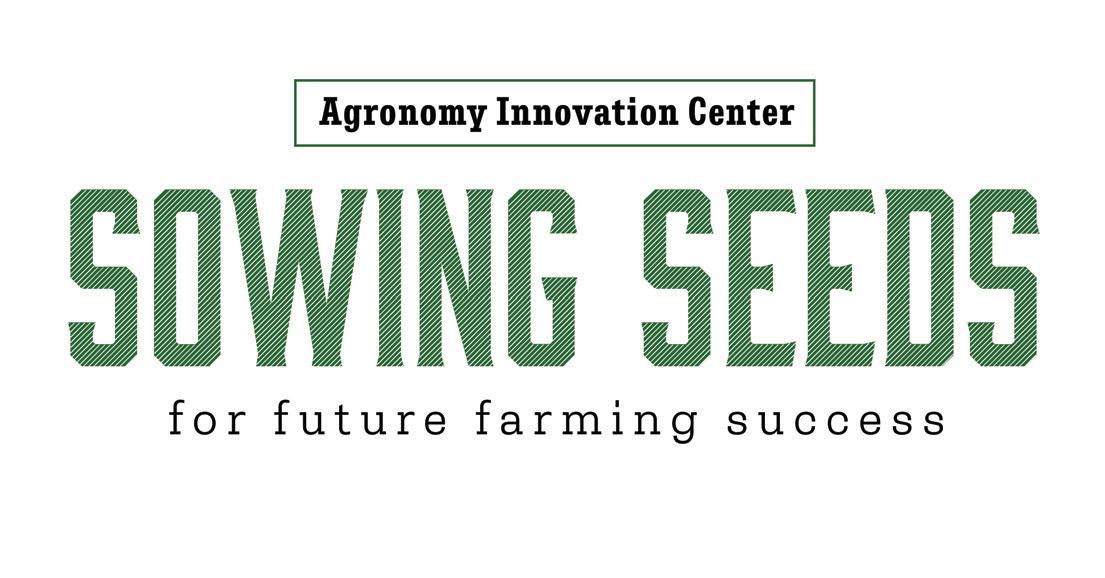

Agronomy is the art of nurturing the earth, transforming seeds into sustenance, and cultivating the future one field at a time.
The Agronomy Innovation Center at Rend Lake College serves as a crucial connector between Southern Illinois communities, families, and the future of agriculture. This innovative facility is dedicated to helping students apply the knowledge they gain in traditional agricultural education by utilizing the latest technology available today. Focusing on Southern Illinois’ agricultural roots, the Center equips students with hands-on experience that prepares them to enter the workforce with a competitive edge.
Blake Patton, Director of the Agronomy Innovation Center, emphasized, “We’re not just teaching the fundamentals here; we’re helping students learn how to apply this knowledge with precision and accuracy. This is what sets our graduates apart.” By working closely with the region’s farming families and local communities, the Agronomy Innovation Center provides a unique opportunity to combine crop
science, soil science, agricultural business, and mechanical skills with cutting-edge tools and equipment. This approach ensures students not only learn agricultural fundamentals but also how to apply modern technology effectively, enhancing their future careers and benefiting the agricultural economy of Southern Illinois.
The Center offers a new digital agriculture degree program that integrates computer programming and software use with traditional agricultural studies. This dual-approach curriculum is designed to equip students with the skills necessary to meet the growing technological demands of modern agriculture. As agricultural processes have evolved from mechanical to hydraulic to electronic applications, the need for students to stay current with technological advancements is more important than ever “Today, with just the push of a button, we can make real-time
adjustments in the field,” Patton noted. The Agronomy Innovation Center ensures that students are prepared for these challenges by incorporating real-time field adjustments and precision technology into their learning experience.
Strong partnerships with local and national industry leaders, such as Syngenta, John Deere, Sydenstricker Nobbe Partners as well as Riechmann Bros, enable students to gain invaluable experience right in the heart of Southern Illinois. These collaborations allow students to apply their classroom learning in practical settings, ensuring that they are fully prepared for the demands of a modern agricultural career. “Syngenta has been a phenomenal partner, allowing us to use excess seed and technology so students can get real-world experience,” Patton shared. By working closely with local high schools and FFA chapters, the Center promotes these opportunities to Southern Illinois students, ensuring that future agricultural leaders are developed right here in the region.
Blake Patton, a native of Southern Illinois and an alumnus of Rend Lake College, leads the Agronomy Innovation Center with a deep commitment to giving back to the area he grew up in. His passion for ensuring that local students have access to top-tier agricultural education drives the Center’s mission to prepare students for successful careers, whether they enter the workforce or continue their education at prestigious institutions like SIU.
The Agronomy Innovation Center is indicative of Rend Lake College’s dedication to supporting the agricultural traditions of Southern Illinois while embracing the future. By providing students with the skills and knowledge needed to lead in the modern agricultural industry, the Center ensures that Southern Illinois continues to thrive as a hub of agricultural innovation for years to come.

“We’re not just teaching the fundamentals here; we’re helping students learn how to apply this knowledge with precision and accuracy. This is what sets our graduates apart.”
– Blake Patton, the Director of the Agronomy Innovation Center



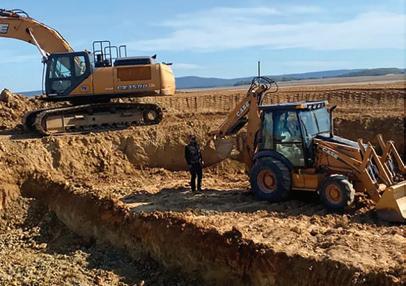
Turningwaste into power:
How Compressed Energy Solutions is Revolutionizing Agriculture
In the heart of Southern Illinois, innovation is sprouting from an unexpected source—manure. With years of experience capturing methane from abandoned coal mines in Southern Illinois, Chris Schimp and his company, Compressed Energy Solutions (CES), are pioneering a transformative approach to capturing sources of methane in the agriculture industry.
While much of the climate conversation centers on carbon dioxide, methane is a far more potent greenhouse gas. With agriculture responsible for nearly 10% of global methane emissions, finding solutions is critical. Enter Schimp, whose vision is to turn a naturally occurring greenhouse gas into a valuable form of energy.
Just east of Harrisburg and Eldorado, amid the sprawling corn and bean fields, lie two unassuming concrete pits built into a hillside. Here, Schimp’s natural gas-powered semis roll in, loaded with manure collected from livestock farms across Southern Illinois.
This is not just any waste; it’s the raw material for a process that mimics nature. Once delivered, the manure is pumped into the massive pits and heated to 98 degrees—essentially creating a giant, simulated stomach. At this temperature, the manure begins to emit methane, a gas that CES is keen to capture.
But instead of allowing this potent greenhouse gas to escape into the atmosphere, CES captures the gas, purifies it, and converts it
into natural gas. This gas is then directed into a nearby natural gas pipeline, ready to power homes, businesses, and even vehicles.
“As a Mining Engineer I have always supported fossil fuel energy and there is a lot of investment in clean coal technology. However, we also need to invest in renewable energy as the population of the world increases,” explained Schimp.
The story does not end there. Once the methane has been extracted, the remaining manure is returned to the farmers who provided it, now transformed into nutrient-rich fertilizer. This fertilizer is spread across fields, helping to grow the very crops that will feed the animals, continuing a sustainable cycle that reduces waste and maximizes efficiency.
What Schimp and CES are doing is more than just innovative—it is a glimpse into the future of agriculture. By turning a waste product into a renewable energy source, CES is not only reducing methane emissions but also creating a closed-loop system that benefits both farmers and the environment. In a world where sustainable practices are increasingly crucial, CES is showing that the path to a greener future might just start with something as simple as manure.
TO HE AR MOR E
CES story with WJPF’s Tom Miller












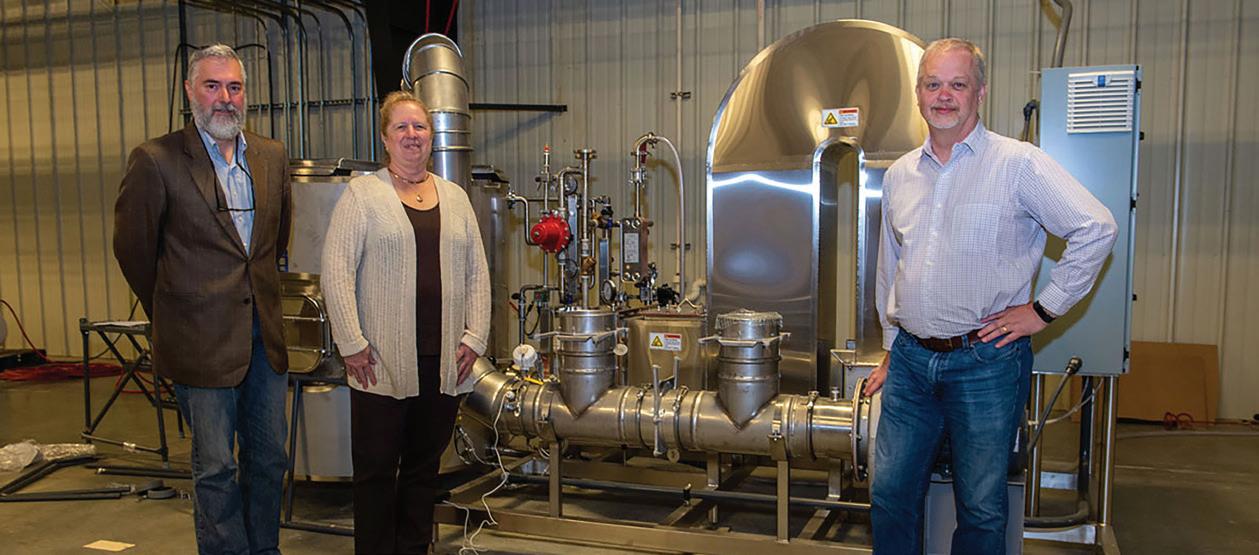
SOUTHERN ILLINOIS UNIVERSITY CARBONDALE FERMENTATION SCIENCE INSTITUTE
INNOVATION Brewing up
Did you know that behind many of the foods and beverages we enjoy every day like cheese, yogurt, and sourdough bread—lies the ancient art of fermentation? And yes, it’s not just about beer, though it’s a well-known fact. This age-old process doesn’t just preserve food; it transforms raw ingredients into flavorful, nutritious, and value-added products. Cheers to that!
Southern Illinois University (SIU) Carbondale is home to a unique program that’s recently celebrated its tenth year of delivering educational courses and testing services to the region and beyond. The Fermentation Science Institute (FSI) has been a bridge between traditional farming and cutting-edge food and beverage production. “We use the FSI services to tie these concepts and themes together,” says Dr. Matt McCarroll, Director of the FSI. “Our activities are deeply focused on value-added agriculture, either through fermentation or other innovative processes.”
Training the Next Generation of Food Entrepreneurs
McCarroll’s journey with SIU began in 2000 as an assistant professor of chemistry. His work eventually led him to explore fermentation, starting with a course on the chemistry of beer and brewing in 2012. Initially designed as a “creative” way to teach science to non-science majors, the course quickly evolved into something much larger, reflecting the growing craft beer movement. “We started developing the idea of a degree program to train students, because at that time, there were really only a few universities nationally that had histori-
cally trained students to go into those kinds of professions,” McCarroll recalls. At the heart of FSI’s operations is hands-on education. The facility features pilot facilities that allow students to gain realworld experience in brewing, distilling, and food production. “Our students can actually develop and make a product, bring it to the consumer, and set it up in a licensed production facility. If we can sell the product, pay our students for the work they’re doing, and break even, that’s a win,” says McCarroll.
A Focus on Specialty and ValueAdded Agriculture
One of the key aspects of FSI’s mission is to enhance value-added agriculture—a concept where raw agricultural products are transformed into more valuable goods, like milk into cheese or barley into malt. This is particularly relevant in Southern Illinois, a region historically rich in agriculture but seeking new avenues for economic growth.
The program has already seen success with its malting facility, which allows students to process barley and other cereal grains grown on the university farm. “We’ve been making malt with our students for two, almost three years. In fact, we’re the first commercial malting operation at a university in the country.”
Fermentation is probably the most common way that we add value to agriculture. For example, if you take corn starch and use it to grow microbes that produce lysine, an essential amino acid that
your body needs, that’s a fermentation process that transforms a basic crop into a high-value product.
Connecting Agriculture and Entrepreneurship
The impact of FSI activities goes beyond campus. By collaborating with local farmers, the institute is helping to revive crops like barley, which once thrived in Illinois before declining in favor of corn and soybeans. “Farmers we’ve talked with are super interested in having an additional crop to diversify. Tying back into value-added agriculture could open up new markets and bring back some of those traditional crops,” McCarroll explains.
FSI also supports local and regional businesses through certified testing services for beer, wine, and spirits, helping to bring new products to market. “We’re one of the few labs certified by the Federal Tax and Trade Bureau, and we’ve helped over 150 clients since 2016,” says McCarroll. “It’s amazing to see the impact we’re having. I can go to the grocery store, see products on the shelf, and know that we had a hand in bringing them there.”
Through FSI, SIU Carbondale is working to expand business development opportunities, not just in traditional areas like beer and spirits but also in less obvious sectors such as dairy, soy products, and even biotechnology.
Looking to the Future
With FSI established, McCarroll is excited to be part of the new Illinois Food, Entrepreneurship, Research, and Manufacturing Hub (iFERM Hub) at SIU. Located on the west side of the SIU campus, the iFERM Hub has been established to solve food, nutrition, agriculture, and health challenges through transdisciplinary research, innovation, and education.
On October 4, 2024, a ribbon cutting was held at the iFERM Hub for its newest program—BioLaunch. Consisting of five key components— biotechnology, analytical, and mass spectrometry labs; a meeting space; and a business incubator program—BioLaunch combines many of the core research facilities and resources to support businesses in Illinois as leaders in fermentation, value-added agriculture, and biotechnology, accelerating opportunities and innovative solutions that spur economic development in the state.
According to Dr. Costas Tsatsoulis, Vice Chancellor for Research at SIU, FSI, BioLaunch, and the other programs and services in the iFERM Hub are the foundation of SIU’s strategic plan research and innovation pillar. “By prioritizing innovation, education, and community engagement, iFERM is primed to make a significant and lasting impact on Southern Illinois, unlocking the region’s potential one innovation at a time.”
LE AR N MOR E
To learn more about Southern Illinois University Carbondale’s Biolaunch
Chambers of Commerce serve our region and work together on projects that enrich and impact our businesses and communities. Don’t miss out on this year’s ‘Shop Southern Illinois’ weekly online contests!
2024 ‘Shop Southern Illinois’ Schedule
11/11 - 11/15 Carbondale
11/18 - 11/22 Carterville
11/25 - 11/29 Marion & Saline County
12/2 - 12/6 Benton/West City
12/9 - 12/13 Jefferson County
12/16 - 12/20 Murphysboro
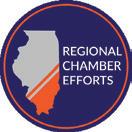




Southern Illinois Regional Chambers include: Benton / West City, Carbondale, Carterville, Centralia, DuQuoin, Hamilton County, Herrin, Jefferson County, Marion, Metropolis, Murphysboro, Nashville, Pinkneyville, Salem, Saline County, Sesser, Union County, West Frankfort, and regionally through the Black Chamber of Commerce of Southern Illinois.
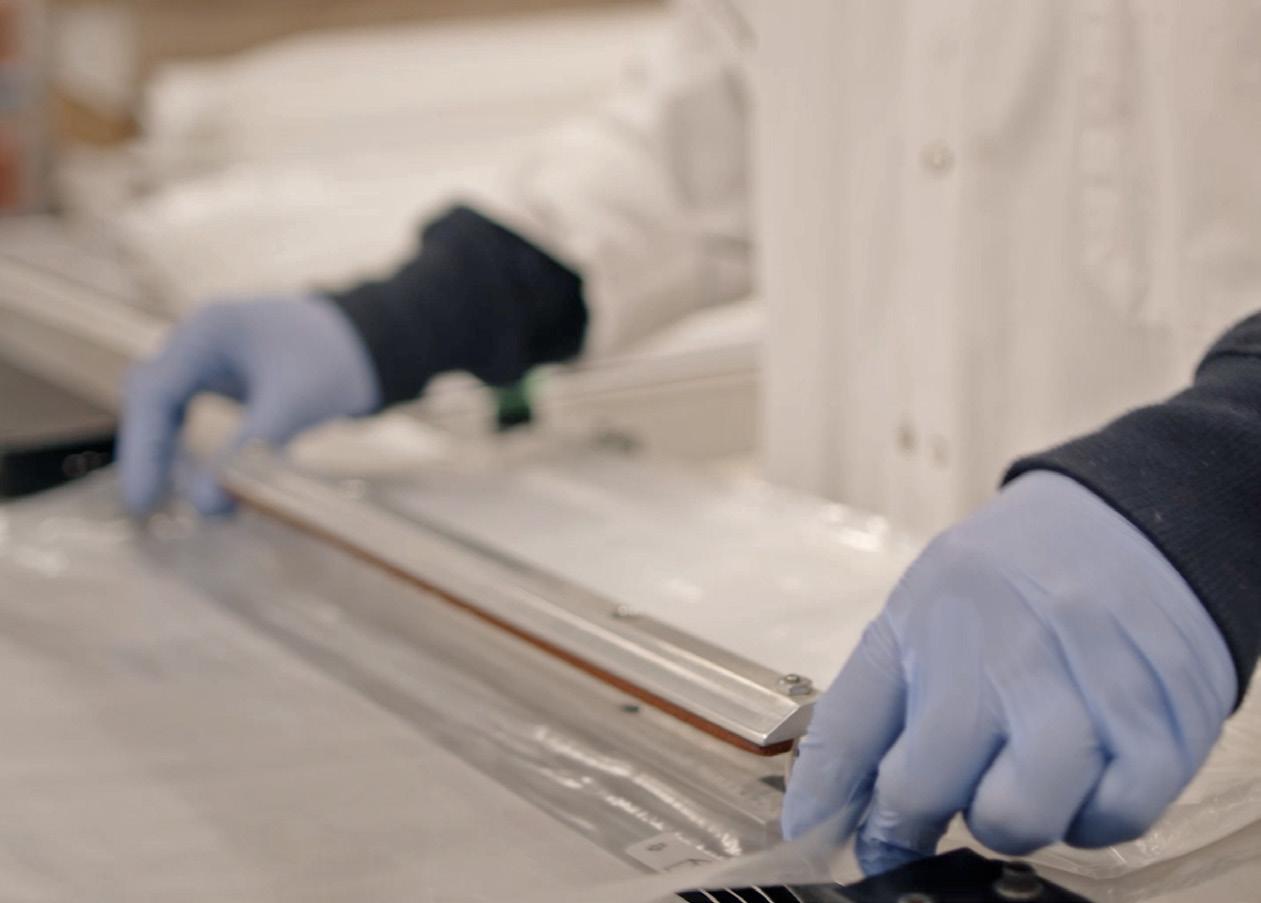
Manufacturing in Southern Illinois:
The Lifeblood of Our Community
In Southern Illinois, manufacturing isn’t just an industry—it’s a way of life. It’s the hum of machines echoing through generations, the hands-on craftsmanship passed down from parent to child, and the sense of pride that comes from creating something tangible and lasting. For the people of Southern Illinois, manufacturing represents more than just jobs; it’s the very fabric of our communities, weaving together our history, our values, and our future.
Walk through any town in Southern Illinois, and you’ll see the fingerprints of manufacturing everywhere. It’s in the local businesses that have been family-owned for decades, where generations have worked side by side, contributing to something greater than themselves. It’s in the camaraderie of the factory floor, where colleagues become lifelong friends, bound by the shared experience of hard work and dedication. And it’s in the pride that comes from knowing that the products we make here aren’t just shipped out—they’re built into the everyday lives of people across the nation.
Manufacturing in Southern Illinois is about resilience and ingenuity. Our region has weathered economic shifts, global competition, and technological change, but through it all, our manufacturing sector has stood strong, adapting, and evolving to meet the challenges of the times. This resilience is reflected in the people who
work in manufacturing—skilled, hardworking individuals who take pride in their craft and their community.
For many in Southern Illinois, manufacturing isn’t just a job; it’s a legacy. It’s the stories told over dinner tables about the workday, the pride of seeing a product on a store shelf and knowing you had a hand in making it, and the security of knowing that your efforts are helping to support your family and your neighbors Manufacturing jobs have provided a stable foundation for countless families, enabling them to build lives, send their kids to college, and invest in their communities.
But manufacturing here is also about innovation and opportunity. It’s where tradition meets progress, as our local manufacturers embrace new technologies and practices to stay competitive in a global market. From the small machine shops to the large-scale operations, there’s a spirit of innovation that drives Southern Illinois forward, ensuring that our manufacturing sector not only survives but thrives.
The people of Southern Illinois understand that manufacturing is more than just an economic engine—it’s a source of pride, identity, and community strength. As we look to the future, we know that the success of our region is tied to the success of our manufacturers. Their stories are our stories, and their successes are our successes. Manufacturing is, and always will be, the lifeblood of Southern Illinois.
Illinois Manufacturing Excellence Center (IMEC)
Southern Illinois’ manufacturing sector is experiencing a transformative period, sustained by the innovative efforts of the Illinois Manufacturing Excellence Center (IMEC) and the Illinois Manufacturers’ Association (IMA). Together, they have launched a groundbreaking Supply Chain Center aimed at revolutionizing the state’s manufacturing landscape1.
This is particularly significant for Southern Illinois, where manufacturing serves as a foundation of the regional economy. The Supply Chain Center is designed to cater to small and mid-sized manufacturers (SMMs) and original equipment manufacturers (OEMs), providing comprehensive support to strengthen their supply chains. It promotes local sourcing and diversity within the industry, which is crucial for the economic growth and sustainability of the region1.
The center offers a suite of essential services, including supplier scouting for Buy America and sourcing requests for potential new business. This enables businesses to access experts who can help find suppliers both in Illinois and nationwide By facilitating responsible and sustainable sourcing, the center supports the development of onshoring supply chains and helps manufacturers foster a stronger connection to their local communities.
Moreover, IMEC’s impact on Illinois’ economy is substantial. Their work has led to the creation and retention of 6,176 jobs, provided a 19:1 return-on-investment, and assisted 1,144 companies. The average cost savings per company assisted is $79,640, with an average of $1,565,893 in new and retained sales per client. This translates to an aggregate impact of $646,455,900 on the Illinois economy2.
The focus on strengthening the supply chain is a response to recent global disruptions, emphasizing the need for a resilient American manufacturing sector. The Supply Chain Center’s services are in high demand, with manufacturers seeking to localize their supply chains within a three-hour radius of their facilities, moving away from global dependencies3.
The manufacturing sector in Southern Illinois is set to benefit greatly from the resources provided by IMEC and IMA. Their focus on innovation, local sourcing, and supply chain resilience is creating fertile ground for growth and ensuring that Southern Illinois remains a competitive and prosperous region for manufacturing.
1. https://www.imec.org/illinois-manufacturing-excellence-centerimec-and-the-illinois-manufacturers-association-ima-launchinnovative-supply-chain-center-transforming-the-manufacturingindustry-in-illinois/
2. https://blog.imec.org/imec-is-25-and-were-making-it-all-aboutillinois-manufacturing
3. https://www.nprillinois.org/illinois/2023-07-13/new-supplychain-center-aims-to-connect-illinois-manufacturers-to-reliablesources-closer-to-home
GROWING SOUTHERN ILLINOIS MANUFACTURING
With support from USDA Rural Development, SI Now recently partnered with the Illinois Manufacturing Excellence Center (IMEC) to analyze the region’s manufacturing supply chains with the goal of revealing needs, understanding potential supply chain challenges and opportunities, and assisting local manufacturers with resilience strategies for long-term business/ job retention and growth.
This project will also provide foundational data to identify regional clusters for potential attraction of new companies in Southern Illinois and centers of gravity that could be useful to attracting suppliers seeking to expand operations to the Midwest to regionalize distribution channels.
The Southern Illinois Supply Chain Analysis project was made possible by a USDA Rural Business Development Grant awarded to SI Now in partnership with the Illinois Manufacturing Excellence Center.

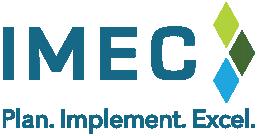

Milling Milestones: GILSTER-MARY LEE’S LEGACY OF SUCCESS
Established over a century ago, the legacy of Gilster-Mary Lee stands as a cornerstone of industry and community in Southern Illinois. As a premier manufacturer of private label food products, the company plays a vital role in local, regional, national, and even the international food supply chains. Proud to call Southern Illinois home, Gilster-Mary Lee is not just a manufacturing powerhouse; it is an integral part of the economic and social fabric of the region, significantly impacting the area through job creation and community engagement. The company actively promotes the region, encouraging other businesses to recognize and seize the vast opportunities available in Southern Illinois.
A Rich History Rooted in Community
Gilster-Mary Lee’s origins date back 129 years, celebrating that milestone in August 2024. This longevity is rare in today’s business landscape. Today’s President and CEO, Tom Welge, attributes this endurance to a blend of good fortune, divine guidance, and, most importantly, the dedication of their employees and communities
“The communities where we operate, the employees that have been dedicated to the business from the early years on through today, and some good leadership have all played a part,” Welge explains. Being a private company has also allowed Gilster-Mary Lee to operate with a long-term perspective, avoiding the pressures of rigorous quarterly earnings reports that public companies face. This freedom has enabled them instead to reinvest in the business and the community consistently.
Family Values and Leadership
Gilster-Mary Lee is a family affair, with Welge being the fourth generation in the business. Additionally, he has several family members employed by the company at various levels of responsibility. Emphasizing the family’s deeprooted involvement. “My nephew is fifth generation (and) is now in sales.”
This generational continuity has provided stability and a sense of identity to the company. Welge recounts how his great-great uncles started the business as Gilster Milling, producing flour in Southern and Central Illinois. Over time, the company transitioned from a local flour mill to a national private label manufacturer in the 1960s under his father’s leadership.
Adapting to Market Changes
The shift from producing their own brands to focusing on private label manufacturing was a strategic move that ensured the company’s survival,
as many localized mills were closing their doors because they couldn’t compete with the larger companies.
This adaptability has been crucial in navigating the competitive landscape. Gilster-Mary Lee’s ability to manufacture a diverse range of products—from cake mixes to microwave popcorn—allows them to offer unique value to their customers. “Our business is very complex because we make about 5,000 different SKUs today,” Welge notes, highlighting their competitive advantage. “We make products for brands like IGA, Kroger, and Walmart. They come to us wanting products similar to wellknown brands, and we produce them.” Welge explains.
Strategic Location and Logistics
Being in Southern Illinois offers strategic advantages for Gilster-Mary Lee. “We have great access to grains like corn and wheat and a central location for distribution across the U.S.,” Welge says. This proximity to raw materials and population centers optimizes their supply chain, enhancing efficiency and reducing costs.
The company employs a variety of transportation methods, including trucks, rail, and even ocean-going containers, to ensure their products reach markets worldwide.
Community Impact and Economic Stability
Manufacturing jobs are crucial to the economic vitality of Southern Illinois’s small towns, where opportunities can be scarce. Gilster-Mary Lee offers not only entry-level positions for new workforce entrants but also significant opportunities for career advancement, serving as a key pathway for long-term professional growth. The company nurtures a skilled workforce capable of advancing from basic roles to mana-
WELL-DESERVED CONGRATULATIONS ARE DUE!
Gilster-Mary Lee Corporation, in partnership with Stannum Core Solutions LLC, has become the first-ever Spectrum Certified® employer, setting a new standard for neurodiverse employment. This certification recognizes Gilster-Mary Lee’s efforts to integrate a neurodiverse workforce across its manufacturing locations in Perryville, MO, and Steeleville, IL. The certification was presented by Stannum Core’s CEO and Founder, Ben Schatzel, at a ceremony on October 1st, coinciding with National Disability Employment Awareness Month and Manufacturing Month. Under the Spectrum Certified® model, Gilster-Mary Lee has expanded talent pipelines, enhanced productivity, and provided competitive career pathways for neurodivergent job seekers, who are valued for their skills and positive impact on the business. Stannum Core Solutions, founded in 2022, specializes in innovative neurodiverse workforce strategies and aims to replace outdated disability employment models with integrated, competitive employment solutions.
Milestones:
gerial or technical positions through on-the-job training and a culture of internal promotion. This strategy boosts individual career development and strengthens the local economy. By investing in its employees, GilsterMary Lee not only enhances the skill set of its workforce but also supports the area’s small businesses and services, thereby reinforcing the economic health of local communities and creating an environment conducive to attracting new businesses and professionals.
This focus helps to encourage working, living, and growing in Southern Illinois
Overcoming Challenges
Like any long-standing business, Gilster-Mary Lee has faced its share of challenges. One of the most significant was the 1993 Mississippi River flood, which inundated their main distribution center with 18 feet of water. “Our business was cut in two, and our employees’ commutes turned into two-hour journeys each way,” Welge recounts. The resilience of their workforce and the support of their customers helped them navigate this difficult period.
During the COVID-19 pandemic, Gilster-Mary Lee faced unprecedented challenges as global supply chains were disrupted and operational hurdles multiplied. “COVID threw all the rules out the window,” Welge remarks. Despite these obstacles, the company’s adaptability and commitment to its employees and customers allowed it to persevere. Amidst the crisis, Gilster-Mary Lee’s critical role in the food supply chain became more evident. “We were extremely busy, supplying grocery stores, feeding programs, nursing homes, and schools,” Welge recalls. This period highlighted the national importance of maintaining a reliable food supply chain, and Gilster-Mary Lee successfully met the challenge.
Celebrating Everyday Moments
Gilster-Mary Lee’s products are a staple in homes across America, participating in everyday moments from birthday parties to family dinners and even providing comfort during funerals. Welge takes
pride in knowing their products help make every food dollar stretch further, especially important for families struggling with grocery costs. “We are part of every person’s everyday life, sometimes just a meal, but often a source of comfort,” Welge reflects, highlighting the role their affordable products play in supporting economically diverse households. Despite their significant presence in the industry, you won’t find Gilster -Mary Lee’s name on their products, because they specialize in producing private-label goods for other brands.
Looking Ahead: Goals and Innovations
Looking to the future, Gilster-Mary Lee aims for measured growth and continued innovation. “We want to have smart growth, pursuing opportunities that make sense for us,” Welge explains. This includes exploring automation to fill gaps in their operations, not to replace workers but to enhance productivity and allow employees to move into higher-skilled positions.
The company is also focusing on unique product innovations. “We’ve developed products like a cauliflower pizza crust mix and a hot honey corn muffin mix,” Welge shares. These innovations cater to evolving consumer preferences and help differentiate Gilster-Mary Lee in the competitive market.
A Legacy of Quality and Trust
Welge is proud of the trust consumers place in American-made food products. “Being American is a big advantage in most other parts of the world. They want American-made food products because of our strong food safety programs and quality processes,” he says. This trust has enabled Gilster-Mary Lee to establish a significant international presence.
Conclusion

Gilster-Mary Lee stands as a beacon of enduring success and community impact in Southern Illinois. With a rich history, strong family leadership, and a commitment to innovation and quality, the company continues to thrive and support the region’s economic health. As Gilster-Mary Lee looks to the future, their dedication to smart growth, community support, and product innovation guarantees they will remain a cornerstone of Southern Illinois for generations. So, when you see their distinguished maroon trucks cruising through the region, you’ll be reminded of their enduring presence and commitment to our community.
50years Continental celebrating
Continental Tire celebrated 50 years in Mt. Vernon, Illinois. For fifty years, Continental Tire has played a pivotal role in Southern Illinois, expanding from a 32-acre facility with 47 employees in 1974 to the extensive plant it is today, employing 3,800 people and covering over 100 acres under roof.
In 1974, General Tire and Rubber Company (acquired by Continental Tire in 1987) saw the potential in Mt. Vernon. The city’s centralized location, easy access to interstates and railways, and its strong, reliable workforce, built on generations of agricultural experience, made it the perfect place to set down roots. Roots that are now firmly planted in the community and the entire region.
“The farm-based, let’s just get the work done mentality, this is what I still see today in our workforce,” said Nik Pearce, plant manager.
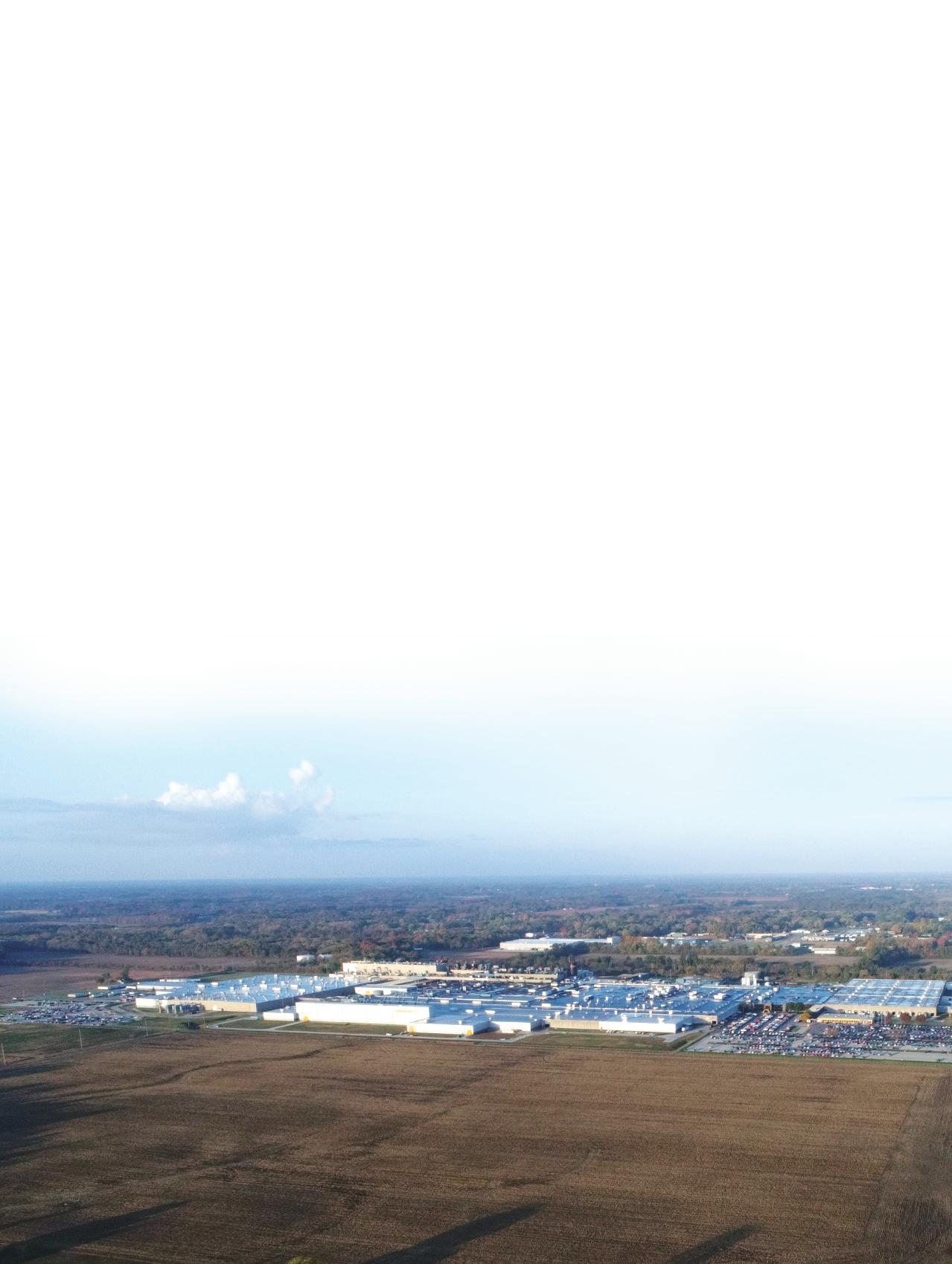
As Continental Tire rolls into its next 50 years, it does so on a foundation of strong relationships, a dedicated workforce, and a community that has embraced it as its own.
That dedication has paid off. The Mt. Vernon plant is now the largest Continental Tire facility in all North America, producing passenger and light truck tires, semi-truck tires, and precured tread. Its success has brought prosperity to the region, making it one of Southern Illinois’ biggest employers.
“We have an amazing team, and we are proud of our ‘American Made Tires’,” shared Pearce. “Our employees genuinely care about providing the best tires for our customers; their dedication and commitment to Continental has made our long history in Mt. Vernon possible.”
The story of Continental Tire in Mt. Vernon is about more than just numbers. It’s about the people. In fact, one employee just recently celebrated their 50th anniversary with the plant this past August, a remarkable feat that speaks volumes about the company’s passion for its workers and the pride employees take in their work. People here aren’t just colleagues; they’re teammates and even extended family. With employees coming from over 150 zip codes, the plant is a true economic driver, stretching far beyond Mt. Vernon’s city limits.



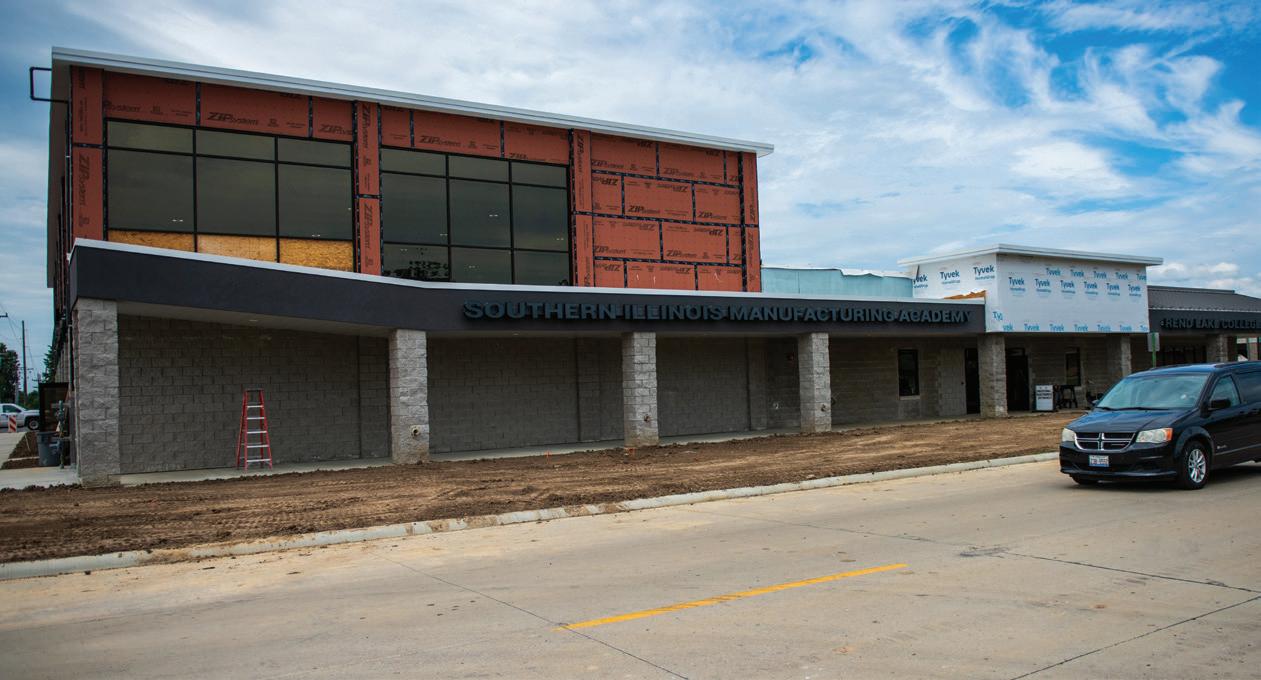
A Game-Changer for Manufacturing Education Introduction to SIMA:
The Southern Illinois Manufacturing Academy (SIMA) at Rend Lake College is more than just an educational facility; it is a transformative program designed to meet the growing demands of the manufacturing sector. Situated in the heart of Southern Illinois, SIMA is set to become a vital community resource, offering specialized training programs and innovative educational opportunities that align with the region’s economic goals.
Vision and Origins: Inspired by FAME Academies
The academy was born from the vision of Rend Lake College’s President Terry Wilkerson and Executive Vice President Lori Ragland, drawing inspiration from successful FAME Academies in Kentucky and Texas. With Illinois pushing for growth in manufacturing to address national shortage, SIMA received a $5,000,000 EDA grant to kickstart its mission. However, there was a unique twist—one of the grant’s stipulations required the production of a tangible product. After careful consideration, the team chose to create something both unexpected and delightful: chocolate Seriously, how could anyone go wrong with chocolate? It is the very essence of everything delicious!
Chocolate Production: A Sweet Opportunity
The decision to produce chocolate was not just a sweet choice—it was strategic. The facility will train students in the confectionery arts while manufacturing chocolate on site. This dual-purpose approach allows students to gain experience in true settings, working in areas like mixing, molding, packaging, and quality control. Equipped with modern machinery such as mixers, molds, and cooling towers, the production area also serves as an educational attraction, allowing visitors to watch the chocolate-making process in action. While branding and distribution plans are still in development, the academy’s commitment to innovation shines through this unique opportunity.
The Role of Culinary Arts: Professor Jeff Fairbanks
Rend Lake College’s Culinary Arts Professor, Jeff Fairbanks, has been instrumental in developing the chocolate production program. He has dedicated himself to understanding the intricate details of food safety, OSHA regulations, and overall production protocols to ensure the facility operates smoothly and safely.
State-of-the-Art Facilities: The High Bay Area
SIMA boasts state-of-the-art facilities, including a high bay area designed for maximum flexibility and efficiency. This adaptable space supports various manufacturing processes and training setups, complete with air and power systems that accommodate forklift certification, welding, machining, and industrial electronics training. The facility’s design allows for quick reconfiguration to meet evolving training needs, making it a dynamic hub of learning and production.
Building a Skilled Workforce: The Heart of SIMA’s Mission
“The academy is not just about education; it’s about building a skilled workforce that can meet the demands of modern manufacturing,” says Chris Sink, Director of SIMA. The curriculum is comprehensive, offering everything from basic mechanical and electrical training to advanced robotics and programmable logic controllers (PLC). By providing handson experience with industry-standard equipment, SIMA equips students with the skills they need to excel in manufacturing.
“The academy is not just about education; it’s about building a skilled workforce that can meet the demands of modern manufacturing,” says Chris Sink, Director of SIMA.

The Southern Illinois Manufacturing Academy at Rend Lake College was established thanks to a $5,000,000 grant from the U.S. Department of Commerce Economic Development Administration (EDA)

Early Exposure: Engaging High School Students
SIMA aims to reach students early in their educational journey. Through dual credit programs and partnerships with local high schools, the academy introduces students to manufacturing as a viable career path. Programs like the Manufacturer Standard Skills Council (MSSC) certification enable students to earn credentials while still in high school, giving them a competitive edge as they enter the labor force.
Addressing the Skills Gap in Manufacturing
Early exposure to manufacturing is critical in addressing the industry’s skills gap. By offering firsthand training and real-world experiences, SIMA helps create a pipeline of skilled workers who are prepared to meet the needs of manufacturing in Southern Illinois.
Shaping the Future of Manufacturing in Southern Illinois
With its unique blend of education and practical application, SIMA is ready to become a leader in manufacturing education. As the academy grows and expands its programs, it will play a crucial role in shaping the future of manufacturing in Southern Illinois, equipping students with the skills they need to succeed and driving the region’s economic development.
Conclusion: A Significant Investment in the Future
SIMA represents a substantial investment in the future of Southern Illinois. By providing top-tier training and producing skilled workers, the academy is doing its part to ensure students have access to well-paying jobs - boosting the region’s economic growth.

Our vibrant community is poised to welcome new businesses with a TIF program, an Enterprise Zone, affordable housing, excellent schools, a downtown historic district, and a vibrant public art and music scene. We’re a haven for small businesses and locally owned restaurants. We’re even the official Barbecue Capital of Illinois. Come see what Murphysboro has to offer. Mayor Will Stephens • 618-684-4961 • murphysboro.com Visit us in Season for
618-893-4241


RAIL – TRACKS THROUGH TIME
In the heartland of America, Southern Illinois stands as a prime example of how rivers, railroads, roads, and runways can converge to create a hub of connectivity that powers economic growth and fosters community development. From the mighty Mississippi River, a natural trade artery that has borne commerce for centuries, to the intricate web of railroads that crisscross the state, connecting goods and people across the nation; from the extensive roadways that facilitate daily life and business, to the runways that open skies for travel and trade—each element of this network plays a crucial role in making Southern Illinois a place of opportunity and a crossroads of American innovation.
Illinois holds a unique distinction in the United States as the only state through which all six Class I railways (seven if you count Amtrak) operate. This extensive network, consisting of approximately 9,982 miles of railroad tracks, with 7,792 miles operated by these major freight companies, positions Illinois at the heart of the nation’s rail system. The presence of these railways underscores the state’s pivotal role in American commerce, connecting the Midwest to every corner of the country and beyond. The convergence of these Class I railroads in Illinois not only facilitates a massive volume of freight traffic but also serves as a critical hub for passenger travel, reflecting the state’s enduring legacy and ongoing importance in the realm of rail transportation.
The railways of Southern Illinois are more than just a network of tracks; they are the essence of the region, a display of its rich history and a symbol of its potential future.
From the early days of steam locomotives to the modern era of freight and passenger trains, the railways have played a pivotal role in shaping the landscape and economy of Southern Illinois.
Railroad construction began in Southern Illinois in the mid-1800s, connecting the Illinois, Ohio, Mississippi, and Wabash Rivers. This network of rails was driven by the need to transport coal, oil, agricultural products, and lumber, spurring investment, and benefiting the rural areas and towns along the railways.
During the golden age, passenger trains were the primary mode of transportation for rural residents to access larger towns for medical care, supplies, and entertainment. The Baltimore & Ohio (B&O) railroad, for example, linked the Illinois River at Beardstown with the Ohio at Shawneetown, while the Louisville & Nashville (L&N) railroad connected the Mississippi at East St. Louis with the Ohio River at Shawneetown and the Wabash River at Maunie.
Today, Southern Illinois’ railways continue to evolve. The state is served by 29 stations and 18 different train services, including the Illinois Zephyr, Illini Service, Saluki, and others, highlighting the ongoing importance of rail transport in the region.
The railways of Southern Illinois are a symbol of progress and endurance. They have adapted to the changing times and continue to serve as a vital artery for commerce and connectivity. As we look to the future, the railways stand ready to transport Southern Illinois into a new era of growth and prosperity.
https://courses.lumenlearning.com/wm-ushistory1/chapter/ on-the-move-the-transportation-revolution/ https://idot.illinois.gov/transportation-system/ network-overview/rail-system.html
https://southernillinoisrailroads.com/ VISIT THESE WEBSITES
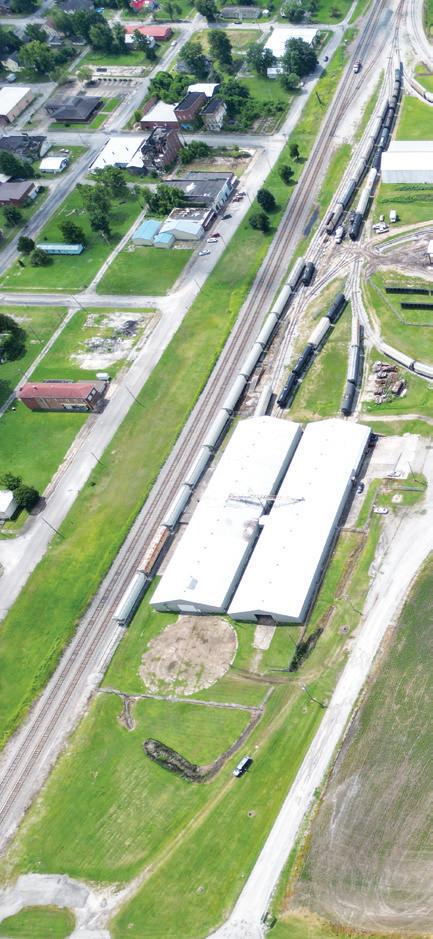
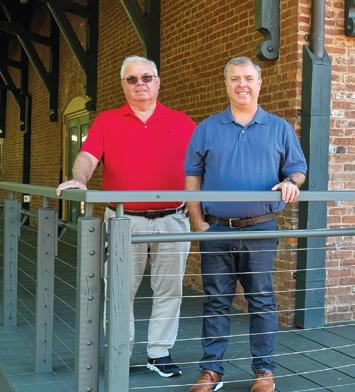
“ER&R is a unique and interesting business, and I am proud that Mr. Doss chose Mounds many years ago as his location to do business. ER&R is woven into the fabric of our community, and Mounds is very fortunate to have this type of business here.” Mayor Rodney Woods
In a small town like Mounds, Illinois, with a population of less than nine hundred, one might not expect to find a business making a significant impact on a national stage. Yet, Environmental Remediation and Recovery, Inc. (ER&R), a company specializing in rail car cleaning and transloading, has done just that. Founded by a group of six individuals, with Eddie Doss being the last remaining original member, ER&R has grown from humble beginnings to a key player in the rail industry.
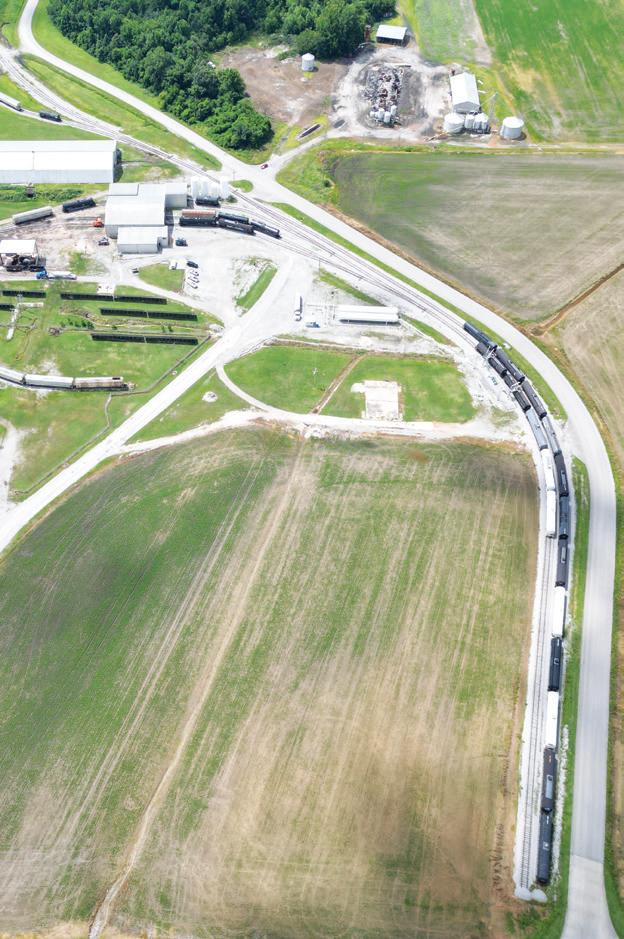
The unique inspiration to start ER&R came from a magazine article. A Memphis BBQ restaurant was raising money for a synagogue fundraiser. For the restaurant to cater the event, they had to have their portable commercial grill Kosher cleaned and blessed. This sparked the inspiration for the development of a specialized kosher cleaning process, which has become a foundation of ER&R’s operations. Today, the company is affiliated with a synagogue in St. Louis, where a rabbi blesses their rail cars, ensuring they meet kosher standards. Although the scope of their operation is dedicated primarily to food grade railcar cleaning, they do address certain other commodities on a case-by-case basis.
Eddie recounted the humble origins of ER&R, where the original headquarters was nothing more than a trailer in a field, with tires on the roof to prevent it from fluttering in the wind. One night, as he was leaving, Eddie expressed a heartfelt wish to God for something better. Remarkably, at around 4:30 the next morning, a tornado swept through and obliterated the trailer. Reflecting on this extraordinary event, Eddie humorously remarked, “I’ve got connections.”
Innovation and Diversification
Picture this: a cheerful beet, plucked straight from the earth, donning its vibrant crimson hues. Little does it know that its destiny lies beyond the salad bowl—it is about to become a road maintenance superstar! Who would have thought? ER&R’s business is not limited to only railcar cleaning. They have diversified into various sectors, including truck wash outs and beet juice for road maintenance. Their strategic location adjacent to the Canadian National line and major interstates has made them a vital hub for transloading operations, including propane distribution from Canada and Illinois. Eddie has an extraordinary knack for generating business ideas. “I have seen him transform ideas into thriving businesses. He
Big keep on wheels rolling!
always finds a way to make things happen,” says Burton Doss, Eddie’s son. Eddie recalls when they initially had around eight hundred feet of track, which has now expanded to over 9,000 feet “When I first saw the original track, I told one of the guys, ‘This is a Grant track.’ They asked, ‘How did you get the grant money?’ I replied, ‘General Grant.’ That is how old it is.” Eddie and Burton mentioned that rail cars arriving and departing originate from places like Missouri, Arkansas, and Eastern Kentucky, among others. The ER&R track currently has the capacity to hold over 120 railcars simultaneously, with plenty of room for expansion.
ER&R’s influence extends beyond their industry. They are a significant supporter of the local community, sponsoring events and contributing to the local economy. Their operations have brought jobs and economic growth to Southern Illinois, demonstrating how a small business can have a significant impact
Burton proudly highlights their 26,000 square foot warehouse and over 30 rail served acres available and ready for a business to locate or expand their operation. He also mentions their revamped website, which now features a modern, user-friendly interface showcasing their expanded services in food-grade rail car cleaning, kosher maintenance, and transloading operations. He emphasizes their goal of raising visibility and awareness about the opportunities in the Mounds area, an often-underestimated community with tremendous assets including access to rail, river, and interstate transportation modes. Burton concluded, “The opportunity for growth in Southern Illinois is ripe.”
With 25 years of consistent service, ER&R is poised for further growth. They aim to expand their transloading operations and attract new businesses to their strategically located property. By highlighting their unique capabilities and central location, ER&R hopes to continue driving economic development in Southern Illinois.
www.errclean.com or by calling 618-745-6562 for additional information!

Multimodal Station (SIMMS): Southern Illinois
A Catalyst for Regional Development

A Vision Realized: The Southern Illinois Multimodal Station
Carbondale, Illinois, is on the verge of unveiling a transformative transportation hub that promises to significantly impact the region. The Southern Illinois Multimodal Station (SIMMS), a $26 million project, will enhance connectivity and drive economic growth throughout Southern Illinois. Initiated by former City Manager Gary Williams, this two-phase project will replace the existing Amtrak station and consolidate various transportation services under one roof, offering a modern, efficient, and inviting environment for travelers and residents alike.
A Journey of Persistence and Vision
The journey to this point has been one of perseverance. The project’s origins date back to 2013, when the city first applied for a TIGER (Transportation Investment Generating Economic Recovery) grant through the U.S. Department of Transportation. Despite multiple rejections in 2013, 2017, and 2018, Carbondale’s determination never wavered. “This project has been a long time coming. It took four attempts to secure the necessary funding, but perseverance paid off,” remarked Steven Mitchell, the Economic Development Director for Carbondale. By 2019, the city secured $18 million through the BUILD (Better Utilizing Investments to Leverage Development) grant, with additional contributions of $2.8 million from the Illinois Department of Transportation and $5 million from the city itself.
Sustainable Design
The SIMMS has been designed to meet the Silver standard of LEED certification, the world’s most widely used green building rating sys-
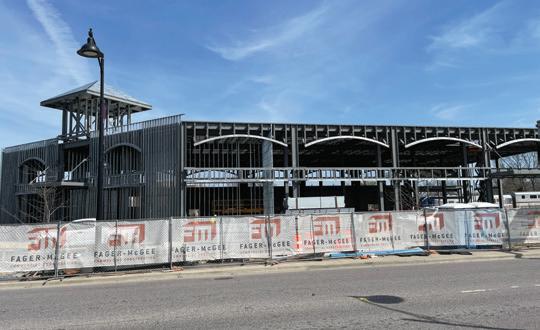
tem. “We designed SIMMS to achieve LEED Silver certification,” stated Project Manager Mark Bollmann. Key sustainable features include a geothermal HVAC system supported by 41 wells drilled 500 feet deep, a 115kW rooftop solar array, native plants that require minimal water and maintenance, and an all-LED lighting system with solar-powered parking lot lights backed up by batteries.
Phased Development
Phase One: The first phase, set to open by the end of this year, includes the construction of the main station area. This section will house the new Amtrak station, complete with a spacious lobby, ticketing counter, and direct access to the train platform. It will also feature office spaces for Man-Tra-Con, a regional workforce development organization, and a co-working space funded by a $95,000 USDA Rural Development grant. This phase represents a significant upgrade in comfort, safety, and aesthetics compared to the old Amtrak station.
Phase Two: Expected to be completed by next summer, the second phase involves demolishing the old Amtrak station and constructing additional facilities. This phase will incorporate Carbondale Tourism, Southern Illinois University, Greyhound, and local transit services, further solidifying SIMMS as a central hub for regional transportation. A notable addition in this phase will be secure bike storage and a designated dog park, aiming to accommodate travelers with pets and encourage eco-friendly transportation options.
Economic and Social Impact
The Southern Illinois Multimodal Station is more than just a transportation hub; it’s a catalyst for regional development. “This project has both local and regional significance,” said Stan Reno, Carbon-
dale’s Interim City Manager. “SIMMS will not only serve the immediate needs of Carbondale’s residents but also provide equitable transportation opportunities across the broader region. The $18.3 million BUILD grant from the U.S. Department of Transportation underscores the importance of this project. We are excited about the opportunities SIMMS will bring for improved connectivity and economic growth in Southern Illinois. This building will be the flagship of downtown Carbondale.”
By providing a centralized location for multiple transportation services, SIMMS addresses a critical barrier for many residents—reliable access to transportation. This is especially impactful for low-income individuals who rely on public transit to get to work. The station will serve as a transfer point between various regional transit companies, offering a streamlined and efficient way to travel across county lines. Locally, the station will offer professional office spaces and a coworking environment, creating new opportunities for business and economic growth. The station’s design, characterized by open sight lines, modern lighting, and ample security, is intended to create a welcoming and safe environment, further enhancing the appeal of Carbondale’s downtown area.
A Vision for the Future
The Southern Illinois Multimodal Station is a key element in the City of Carbondale’s broader downtown revitalization strategy. The city is also planning to construct a new entertainment stage, designed by the same team behind SIMMS, which will complement the transportation
hub and serve as a venue for community events and gatherings. With a capacity of around 7,500 people, this stage will attract visitors and contribute to the vibrancy of downtown Carbondale.
Conclusion
As Carbondale prepares to open the first phase of its multimodal station, excitement is building. This project, born out of years of persistence and vision, is set to transform the region by improving transportation access and fostering economic development. With its completion just around the corner, the station is set to become a key hub in Southern Illinois, linking people, businesses, and opportunities in ways that were previously unimaginable.


MILANO
RAILWAY LOGISTICS
Turning Frustration into Innovation: The Birth of Groundbreaking Business Ideas
Ever wondered why some of the most successful business ideas seem to emerge from thin air? The truth is many of these innovations are born out of sheer frustration. When faced with inefficiencies, outdated systems, or unmet needs, creative minds don’t just accept the status quo—they see an opportunity for change. From the tech guru who couldn’t find a userfriendly app to the entrepreneur tired of bulky wallets, frustration often serves as the catalyst for innovation. By transforming these everyday annoyances into solutions, entrepreneurs not only address their own pain points but also create products and services that resonate with a broader audience. This article delves into a fascinating story of someone who turned their frustration into a highly successful venture, proving that sometimes, the best ideas come from the most unexpected places.
Here’s a story that exemplifies exactly that!
In 2012, Mary Burgan, the president of Milano Metals and Recycling, woke up one morning feeling a profound sense of frustration. “I wasn’t jumping out of bed for work anymore,” she recalls. “To give my best, I have to be engaged, I have to be all in.” As the leader of a fourth-generation scrap iron processing plant located in Mt. Vernon, Mary worked alongside her siblings Michael and Mia. They had been operating together for 27 years.
Mary’s discontent was further fueled by the volatile nature of the scrap iron market. “People think we set the price, but it’s a global commodity. When China hiccups, we can lose $100 a ton,” she explains. With 27 employees depending on them, Mary was determined to find a way to diversify and stabilize their business. “I needed to find something else that would allow us to sleep better at night, without the constant risk and volatility.”
As she walked through the office, she noticed an old aerial photograph of their property. The image, taken in the 1960s, showed
extensive rail lines that had since been removed. Intrigued, she hired a retired Norfolk Southern conductor to help her understand the historical significance of the rail connections and together, they “walked the ghost lines.” “He told me, ‘Mary, you have something really unique here.’ Our property was uniquely positioned at the intersection of major rail lines: Union Pacific, Norfolk Southern, and a short line that connected to BNSF and CSX.”
This discovery led Mary to the concept of transloading—a process where longhaul freight is transferred between different modes of transportation, such as rail to truck. Excited by the possibilities, she threw herself into learning everything she could about the industry. “I told my siblings, ‘You guys run the yard. I’m going to figure this out.’”
The journey was not easy. Building the necessary infrastructure required significant investment. “We had to rebuild 20,000 track feet and create an interchange that could connect multiple rail lines,” Mary explains.
To fund the project, they started stockpiling re-layable rail from their scrap operations. “It took us six years to collect enough rail, but we finally did it.”
With the new rail infrastructure in place, Milano Rail was launched. They began offering services that included transloading, storage in transit (SIT), product laydown yard, and a rail scale. “We’ve gone from a small scrapyard to a 65-acre operation with the capability to service a wide range of industries,” Mary says proudly.
Mary’s passion for the rail industry is palpable. “I used to get frustrated being stopped by a train, but now I can’t get enough. I want to know what’s on it, where it’s going, and how it affects us.” She has become an expert in the field, learning from seasoned mentors and embracing a hands-on approach. “I

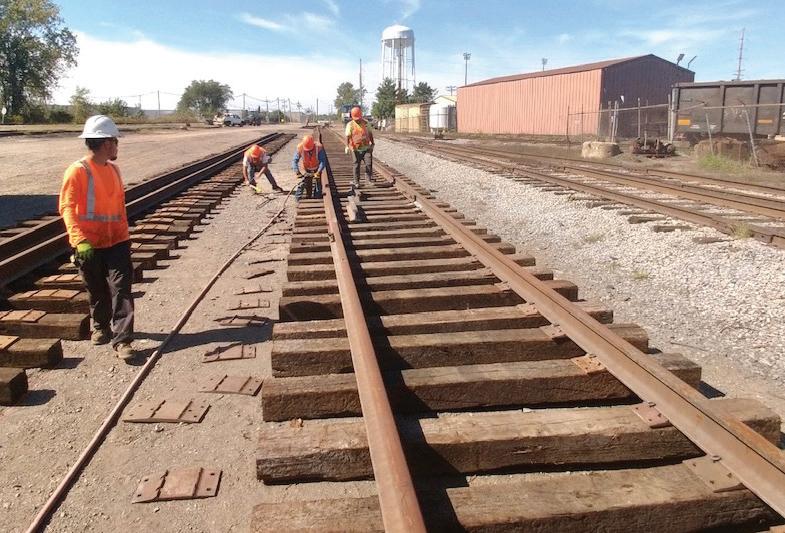
have found mentors in this industry—70- and 80-year-old men who are like angels, guiding me through the complexities of railroading.”
Despite the challenges, Mary and her team have created a thriving business that not only supports their local economy but also offers innovative solutions to their clients. “We are bringing service back to railroading,” she declares. “We’re taking headaches away and helping our customers sleep better at night.”
Thanks to their willingness to collaborate and find innovative solutions at Milano Rail, companies like Manner Polymers are setting up operations in the region. The new facility will span 80,000 square feet, involve a $54 million investment, and is anticipated to create over 60 new jobs in Southern Illinois.
Mary’s story is fascinating and evidence of the power of resilience, innovation, and a relentless pursuit of excellence. Milano Rail has emerged as a symbol of hope and progress in Southern Illinois, demonstrating that even amidst adversity, new opportunities can spring from the most unexpected places.


PAID VACATION (RENEWS EVERY JULY)
WAGE RANGES $21 80 -$39 96
WAGE PROGRESSIONS
RETIREMENT & CONTRIBUTION MATCHING
HOLIDAY SHUTDOWNS
PAID HOLIDAYS
DENTAL, VISION, AND HEALTH INSURANCE
PAID PARENTAL LEAVE
TUITION REIMBURSEMENT
UNION FACILITY
DISCOUNTED STOCK
BID RIGHTS
UPWARD MOBILITY POSSIBILITIES
SHIFT DIFFERENTIAL
PERFECT ATTENDANCE BONUS PAID MONTHLY
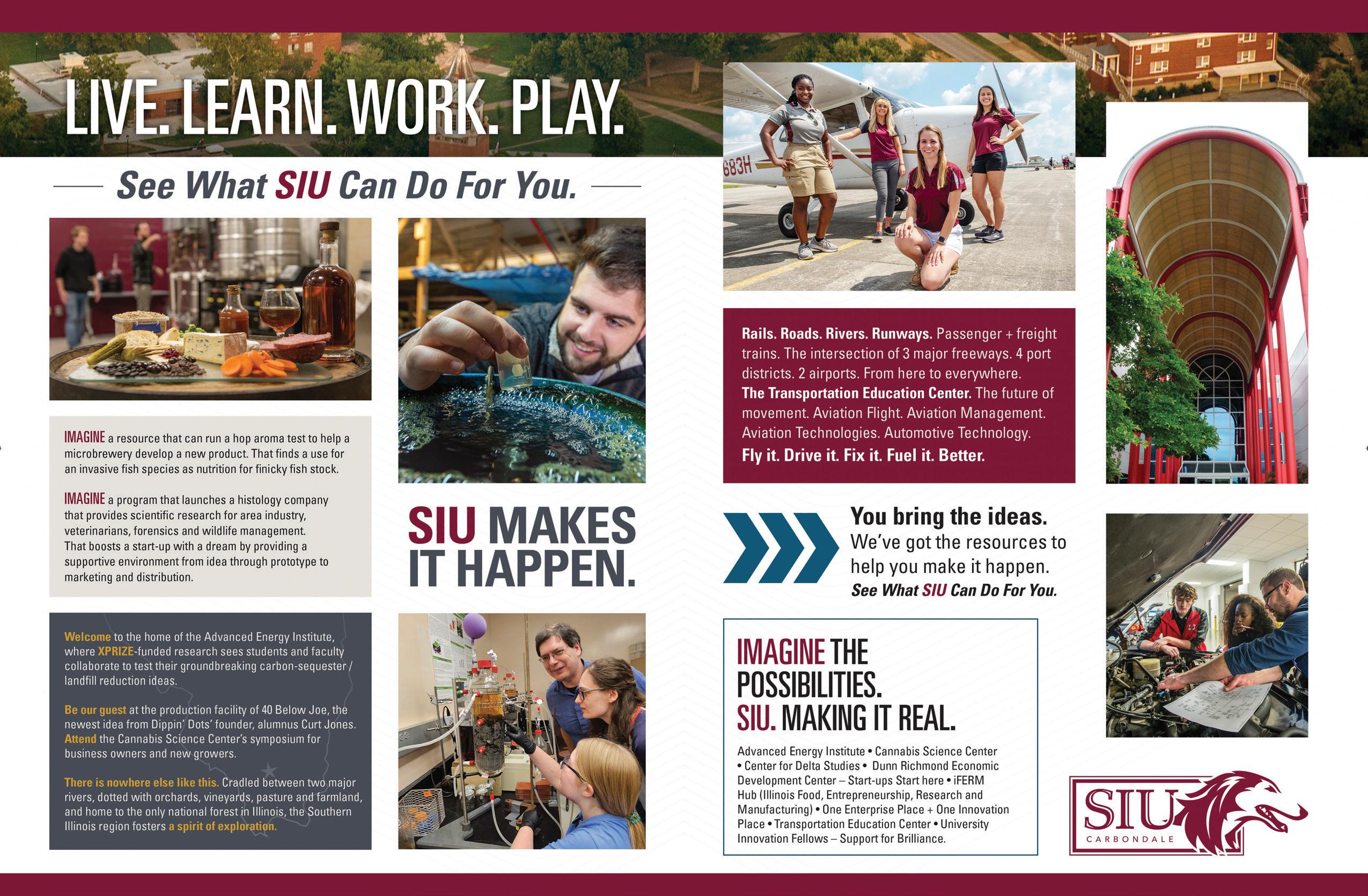

Making SI HOME
– EMBRACING DIVERSITY
FEATURE RESIDENT STORIES
Southern Illinois is home to a variety of communities that celebrate diversity in all its forms. From bustling cities to peaceful rural areas, the region offers a blend of modern living and small-town charm. This diversity is reflected in the local festivals, cultural events, and community activities that bring people together from different backgrounds.
The region boasts several top-notch educational institutions that prioritize inclusivity and diversity. Schools and universities in Southern Illinois offer programs and ideas aimed at fostering a multicultural environment, ensuring that students from all walks of life feel valued and supported.
Local organizations and community groups play a crucial role in promoting diversity and inclusion. These groups provide support and resources for newcomers, helping them
integrate into the community and feel at home. Whether it’s through cultural exchange programs, language classes, or social events, there are plenty of opportunities to connect with others and celebrate diversity.
Southern Illinois is a place where differences are celebrated. The region hosts numerous cultural festivals and events that highlight the unique traditions and customs of its residents. These events not only provide entertainment but also foster understanding and appreciation of different cultures.
By embracing diversity, Southern Illinois creates a vibrant and inclusive environment where everyone can feel at home. Whether you’re drawn to the area’s natural beauty, educational opportunities, or affordable living, you’ll find that Southern Illinois is a place where diversity is not just accepted but celebrated.

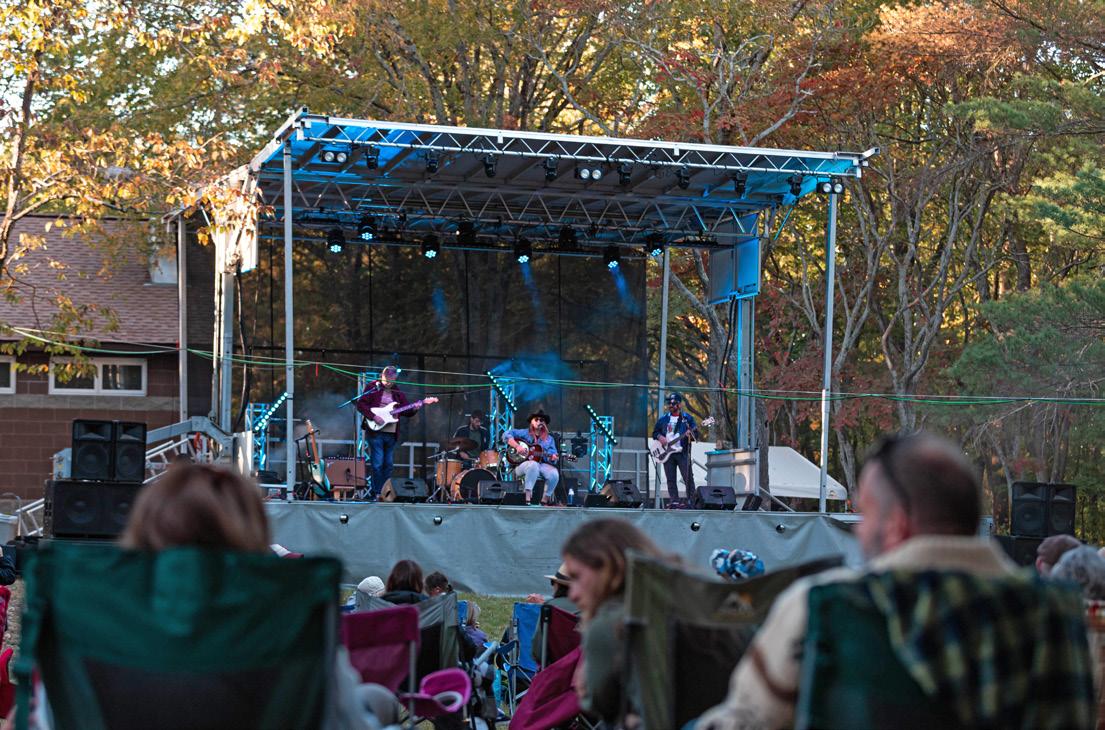
YOUR FUTURE STARTS AT JOHN A. LOGAN COLLEGE

TOP 4 REASONS TO ATTEND JALC:
Affordable Education
Career-Ready Programs
Supportive Environment


EXPLORE OUR PROGRAMS:
Healthcare & Nursing
Hospitality Management
Business & Technology
Seamless Transfer Pathways
Skilled Trades & More!

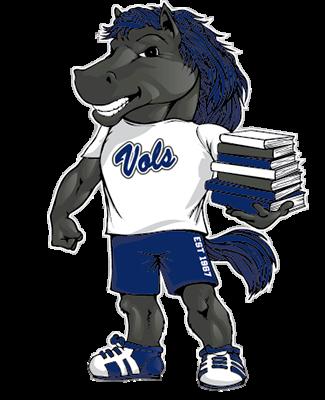

HAROLD S. JONES FINE ARTS CENTER THE POWER OF
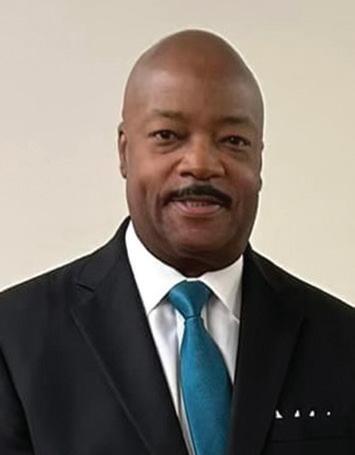
Harold S. Jones’s unwavering dedication to the arts has profoundly shaped the cultural landscape of Cairo. What began as an after-school program has blossomed into a vibrant hub of creativity and learning. Harold’s belief that “If I can see a dream come true, so can you” serves as a powerful reminder of the transformative potential of a single, determined soul. THE POWER OF ONE!

The Harold S. Jones Fine Arts Center in Cairo, Illinois, is a living witness to the dreams of its visionary namesake, Harold S. Jones. Born into a family rooted in Cairo, Harold spent his summers returning to this cherished place, even after his parents had moved away. His heart never truly left. A gifted orchestrator, violinist, teacher, composer, and writer, Harold has crafted a legacy of creativity and inspiration. In 2010, he penned “How to be a Man of Class,” a book offering timeless wisdom on professional etiquette, social grace, and behavior in various settings—a guide for men from all walks of life. He is also the owner of Insurance Research Associates, an insurance claims subrogation company.
In 2009, Harold returned to Cairo to help his aging mother. Yet, during this personal journey, he rediscovered Cairo, seeing it through a lens of possibility and purpose. He envisioned the town as both a “mission field and a blank canvas,” where the seeds of artistic expression could be sown. Recognizing a profound need for fine arts education in a community where schools and homes lacked such resources, Harold declared his desire to “stop chasing the dollar and start chasing the dream.”
Driven by this passion, Harold acquired and transformed the old Cory Brother/Deana Pecord Dance Studio Building in downtown Cairo. This space, now the Harold S. Jones Fine Arts Center, stands as an inspiration of cultural enrichment. The salvaged floors and ballet bars bear silent witness to the building’s storied past, a reminder of the rich history that now supports the future.
Even though Harold was a “Michigan” fan by heart, he draws inspiration from the legendary Ohio State football coach, Woody Hayes, who famously said, “Run where they ain’t.” This philosophy guides the Fine Arts Center, which seeks to fill the gaps and seize opportunities for growth and progress. The walls of the center are adorned with art pieces from various artists, each symbolizing the promise and connection that Harold strives to cultivate.
Serving the under-served communities of Southern Illinois, Western Kentucky, and Southeast Missouri, the center is a haven for all races and creeds. Established as a non-profit in 2018, it offers music, art, and dance lessons to students and adults alike. Beyond education, the center provides a stage for artistic expression and community engagement. The Harold S. Jones Fine Arts Center hosts three major events annually: the Spring Arts and Crafts Fair, the Smooth Jazz on the River Festival, and the Southern Illinois Classical Music Festival. These events showcase local talent and help strengthen community ties.
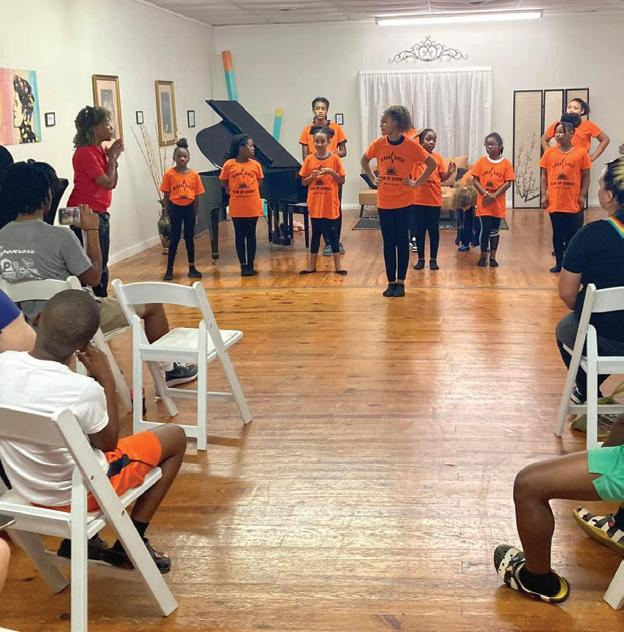
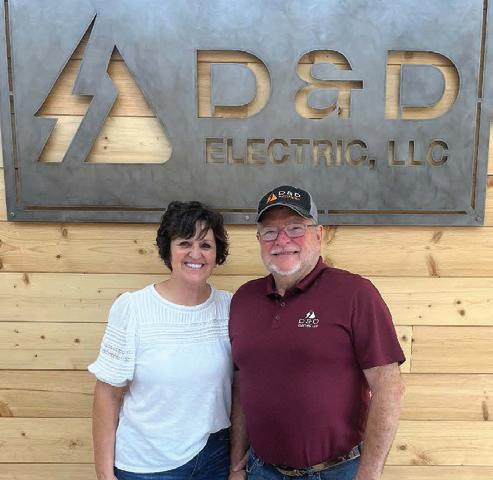
A Bright Future with D&D Electric –
Dave & Darla Martin
We sat down with Dave and Darla Martin, founders of D&D Electric, to hear their impactful story. The history of D&D Electric, formerly known as Dave Martin Electric, “started with three employees in a little hallway” Darla shares and now has nearly fifty employees today. Dave Martin’s career path has been diverse—coal mines, farming, and power plants. He dabbled in entrepreneurship but often returned to familiar territory. In 2012, Dave embarked on a solar energy path when he had the opportunity to install solar panels on a 10-acre farm. The rest has been an inspiring journey focused on sustainable energy solutions.
https://southernillinoisnow.org/ a-bright-future-with-dd-electric/

Matthew 17:20

The JAY Effect Faith, Family, and Flavor!
The JAY Effect, founded in February 2021, is a family-owned business that specializes in low-salt seasoning blends free from artificial ingredients. Their journey began after months of prayer and seeking God’s guidance, culminating in a virtual grand opening on Facebook and Instagram Live. The inspiration for the business came when Yemisi’s husband, James, needed a consistent, low-salt seasoning blend, as many premixed options were too salty. Yemisi suggested they create their own seasonings to meet their needs. Although James was initially hesitant, he embraced the idea after receiving positive feedback from customers. What started as a solution for their catering business has evolved into what you see today!
They love cooking for others, and their spice blends allow them to share that passion even when they’re not in the kitchen.
They have received incredible support since the very start of their business. The assistance from the Illinois Small Business Development Center (SBDC) at Southern Illinois University Carbondale was crucial in properly establishing their business, helping them understand and manage their finances, which in turn boosted their sales. Their church generously allowed them to use its kitchen to make their products, and having a licensed facility has opened more opportunities for them.
The vending community in Southern Illinois has become like extended family to them. With small children, vendors
Their family loves exploring and taking random turns to sightsee, and her husband loves to fish, so being near multiple fishing spots is a bonus. With deep roots in faith, family, and community, The JAY Effect has flourished in Southern Illinois, transforming a simple idea into a beloved local business that embodies their passion for cooking and commitment to healthy living.
have stepped in to rock or comfort a baby so they can attend to customers, and they’ve kept an eye on them during busy times to ensure they don’t wander off. It truly takes a village, and this community has become part of theirs. They genuinely feel blessed to do business in Southern Illinois.
Their friends have also been instrumental, helping them produce larger quantities of their products and assisting with their boys, giving them opportunities they might have otherwise missed. The community support has been amazing, from helping them reach various goals to purchase equipment to encouraging them along the way. One of the goals Yemisi set early on is to have their product in every state of the U.S. As of September 2024, they had shipped product to 45 of the 50 states, with Delaware, Vermont, Rhode Island, Connecticut, and New Hampshire remaining.
They love running a business in Southern Illinois because of the incredible resources and supportive community. They believe God has placed them here, providing exactly what they need in this season. People know them, and while it took some getting used to, they appreciate living in a place where folks recognize them (or at least know Yemisi as the “spice lady”).
While some of their family has tried to persuade them to move back to the city, they love the slower pace and affordability of living in Southern Illinois. Given the environments they both grew up in, they enjoy raising their boys in this area. They’re close enough to the highway that if a city fix is needed, it’s just a day trip away, and they can return to the peace and quiet. “Driving through this area is stunning, especially in the fall, with all the orchards, farms, Shawnee Forest, and lakes,” says Yemisi.
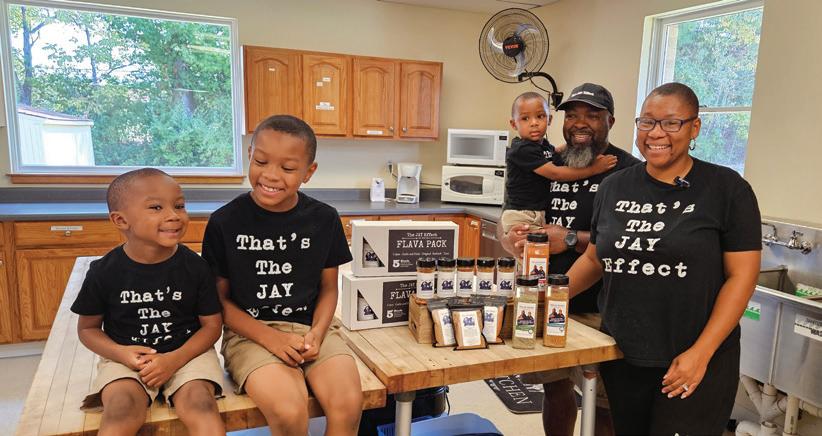
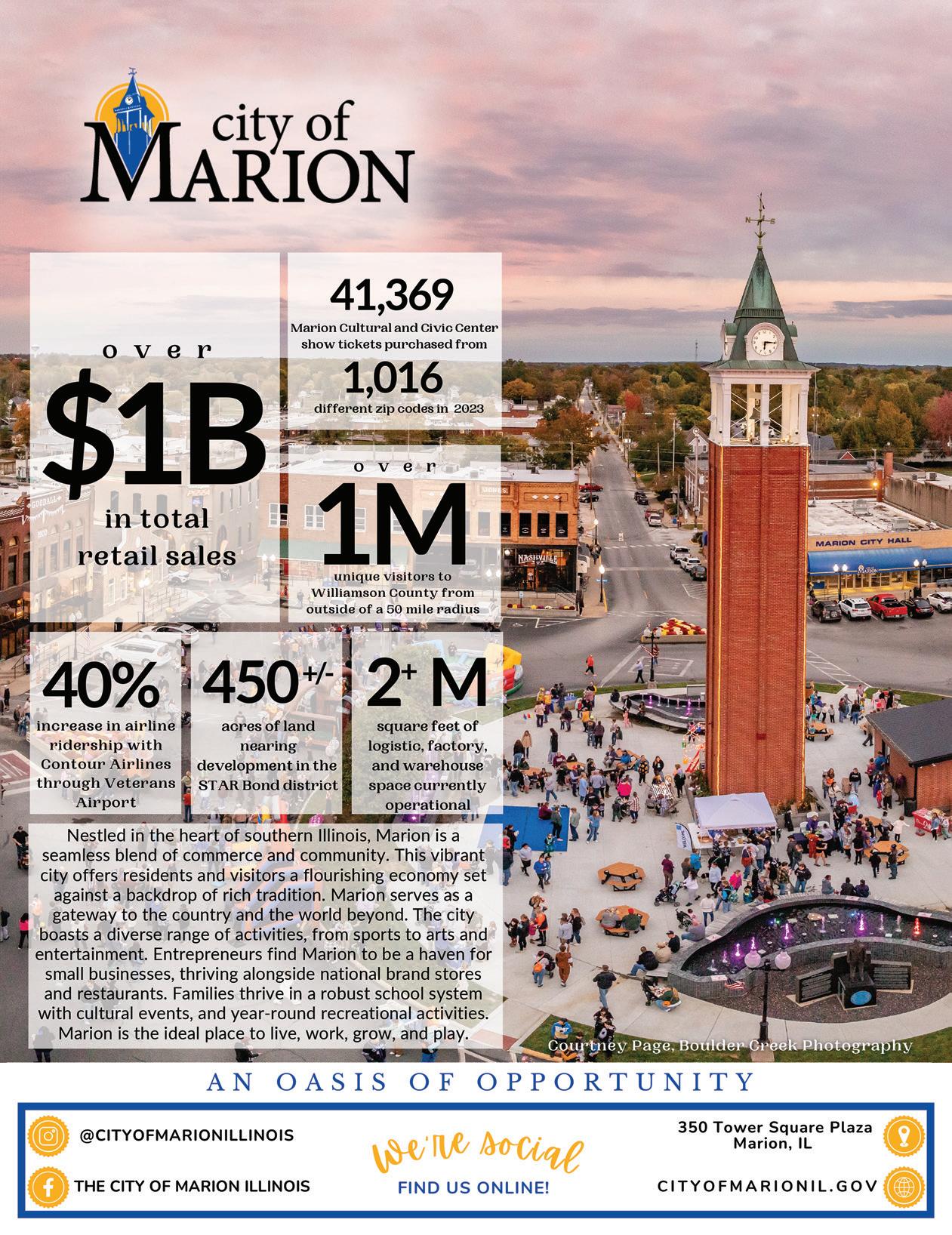

Taking Care of Residents - Robotics
SIH Herrin Hospital Launches Robotic-Assisted Surgery with the da Vinci Xi®: A Bold Step into the Future of Medicine
In August 2024, SIH Herrin Hospital proudly joined its sister facility, SIH Memorial Hospital of Carbondale, in offering cutting-edge robotic-assisted surgery, solidifying Southern Illinois Healthcare (SIH) as the premier destination for advanced surgical care in the region. The acquisition of the da Vinci Xi® surgical system marked a pivotal moment for SIH Herrin Hospital, ushering in a new era of minimally invasive surgery that expands access to worldclass healthcare close to home for patients in Southern Illinois.
“The future is now. This technology allows us to offer our community a broader range of surgical options without needing to travel far from home,” said SIH Endourologist and Chief of Surgery Don Arnold, MD. “The da Vinci Xi® system enables SIH Herrin to expand its surgical repertoire, offering complex procedures in general surgery, urology, oncology, colorectal, and bariatrics. With the addition of this system, SIH now boasts the largest and most experienced robotic surgery program in Southern Illinois, with a combined total of 18 robotically-trained surgeons across both campuses.”
Expanding Robotic Capabilities in Southern Illinois
SIH Memorial Hospital of Carbondale, home to SIH’s first robotic surgery program in 2011, laid the foundation for the expansion. Over the years, Memorial’s program established itself as a leader in the field, with surgeons utilizing advanced robotic techniques across multiple disciplines, including gynecology, urology, colorectal, oncology and general surgeries. The acquisition of the da Vinci Xi® at SIH Herrin Hospital further strengthens SIH’s capacity to meet the growing demand for minimally invasive procedures. In its first month of operation, surgeons at Herrin successfully completed an array of cases, including a robotic kidney removal, gallbladder removals and hernia repairs. Robotic-assisted bariatric surgeries are on deck.
“This state-of-the-art technology brings advanced robotic-assisted surgery to our community, allowing patients to receive top-tier medical care close to home. It’s a tremendous leap forward for our hospi-
tal and the region,” said SIH Vice President and SIH Herrin Hospital Administrator Rodney Smith. He went on to note that these expanded capabilities will improve patient outcomes and make Southern Illinois a hub for sophisticated surgical care.
The Benefits of Robotic-Assisted Surgery
One of the key advantages of the da Vinci Xi® is its ability to perform complex surgeries through small incisions, minimizing trauma to the surrounding tissues. This leads to reduced blood loss, less postoperative pain, shorter hospital stays and quicker recovery times for patients. “Compared to traditional open surgeries, robotic-assisted procedures offer a superior experience for patients,” said Dr. Arnold. “We’ve already seen patients go home faster, relying less on pain medication and getting back to their daily lives sooner.”
The da Vinci Xi® offers an immersive 3DHD vision system that provides surgeons with a highly magnified, three-dimensional view, virtually extending their hands and eyes into the patient’s body. Surgeons control the robotic arms, translating their hand movements into precise, minute actions inside the patient. “The surgeon is in control 100% of the time. This is not a robot doing the surgery—it’s a tool that enhances our ability to perform intricate and delicate procedures with unparalleled precision,” explained Dr. Arnold.
The success of SIH’s robotic surgery program can be attributed to the highly trained team of surgeons who have embraced this advanced technology.
“Our surgeons continue to push the boundaries of what’s possible with this technology,” Dr. Arnold noted. “The da Vinci system not only enhances precision but also helps us attract and retain top surgical talent. Surgeons in training today are learning on robotic systems, and having this technology allows us to recruit the best professionals to serve our community.”
As SIH Herrin Hospital looks to the future, its investment in robotic-assisted surgery represents a commitment to delivering the most advanced surgical care possible. With a growing team of expert surgeons and state-of-the-art technology, SIH is poised to continue transforming the healthcare landscape in Southern Illinois, making it a beacon of medical excellence in the region.
The Future of Surgery at SIH
With the addition of the da Vinci Xi®, SIH Herrin Hospital is positioned to offer an even broader spectrum of minimally invasive surgical options, providing local access to cutting-edge treatments that rival those found in major urban centers. This expansion reflects SIH’s commitment to advancing healthcare technology while maintaining its focus on compassionate, patient-centered care.
“Our mission has always been to bring the best care to our community,” said Rodney Smith. “With the da Vinci Xi, we are not only improving patient outcomes but also ensuring that Southern Illinois remains a leader in healthcare innovation. This is a major milestone for us, and it’s just the beginning of what we’ll be able to achieve with this technology.”

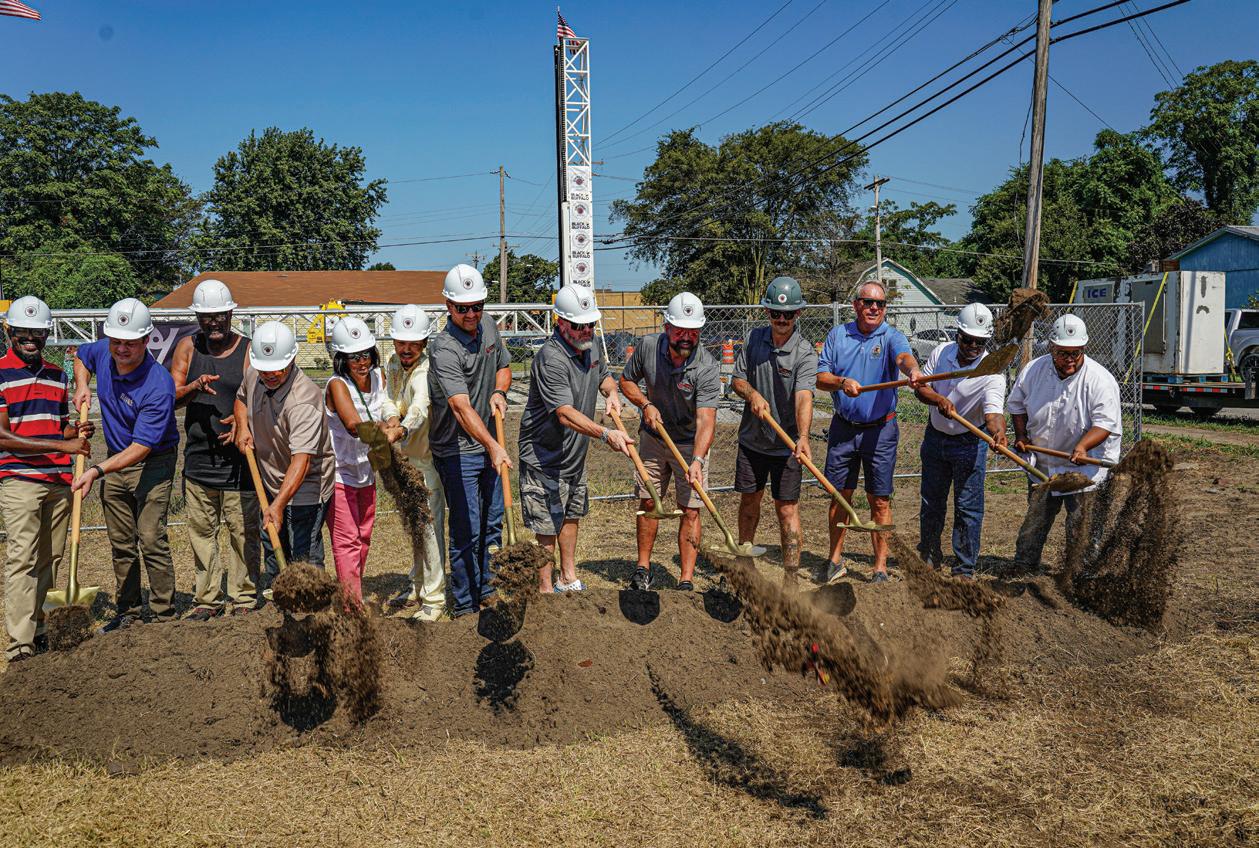
In the heart of Cairo, Illinois, where history whispers through the streets, a new chapter began as the hum of a 3D printer filled the air. In a groundbreaking move to tackle housing insecurity, an ambitious housing initiative is starting. The first duplex, donated by the founders of Eminence Resource, Inc., utilizes Black Buffalo 3D printing technology to address the community’s pressing need for affordable and sustainable housing solutions.

This cutting-edge technology enables rapid construction of durable homes, significantly cutting both labor costs and construction time. The technology employs eco-friendly materials and minimizes waste, presenting a forwardthinking solution for long-term housing challenges. Layer by layer, the first duplex begins from the ground up, its walls telling a story of human innovation and resilience. This isn’t just a building—it is a symbol of rebirth for a town that had weathered the storms of time. As the final touches are made, the duplex will stand tall, a fusion of cutting-edge technology and the enduring spirit of a community ready to embrace the future while honoring its past. Groundbreaking 3D-Printed Housing Initiative Paves the Way for Sustainable Community Revitalization
“Our mission is to make 3D construction printing more affordable and sustainable than traditional building methods. We aim to innovate and improve building practices through cutting-edge technology, providing eco-friendly and cost-effective solutions for the construction industry. We also focus on workforce housing to make a positive impact on Southern Illinois and address the housing crisis we are currently experiencing,” says Shannon Winters, Chief Administrative Officer of Eminence Resource, Inc.
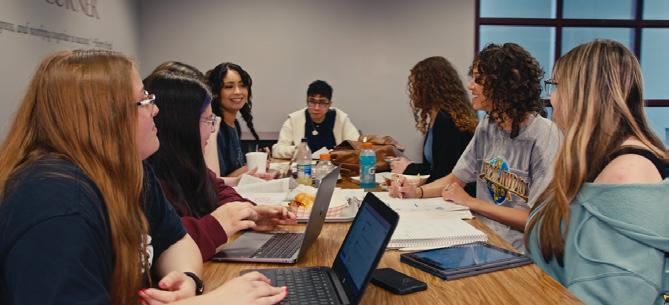

Illinois State Senator Dale Fowler has been a vocal advocate for this project, emphasizing that it is part of a broader strategy to revitalize Cairo and reintroduce relocated families to the community. “This is such an exciting new development to bring displaced families back home.” Fowler said. “This is the start of more development and growth to come for this community and throughout Southern Illinois.” By demonstrating the effectiveness of 3D printing in housing, Fowler hopes to inspire future developments, including additional homes and essential community infrastructure such as schools and community centers.
This represents more than just a technological advancement, it stirs hope for Cairo, bringing new opportunities and fostering a renewed sense of community. As the first 3D-printed house takes shape, it symbolizes a significant step forward.
For those interested in the technology behind 3D-printed homes or other community projects in Southern Illinois, this development provides a fascinating glimpse into the future of construction and community revitalization. As Cairo progresses, the influence of this project is certain to extend well beyond the city, establishing a benchmark for innovative community support.
On Saturday, August 17, 2024, a lively block party was held, offering complimentary food, lunch, treats, giveaways, and a variety of activities, organized by the Fowler Bonan Foundation and agricultural giant ADM. It was a celebration of the exciting developments happening in Cairo. A tangible sense of renewed hope permeated the air as the community came together to celebrate the promise of the future.
https://www.nprillinois.org/illinois/2024-08-19/ in-cairo-massive-3d-printer-provides-affordablehousing-hope MOR E INFOR MATION
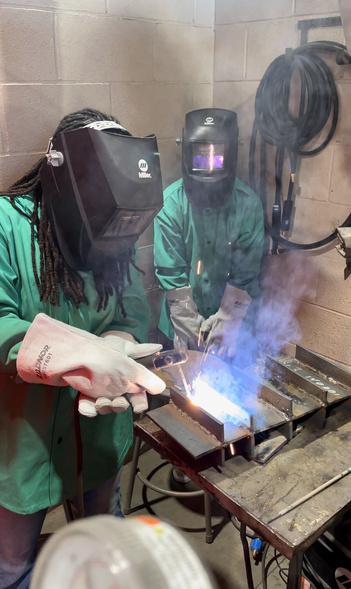



SIU ALUMNI ASSOCIATION
SALUKI HIGHLIGHTS
Fueled by Faith and Determination:
Dylan Chambers’ Remarkable Path from High School Leader to Illinois’ Youngest Alderman and Beyond
Have you ever met someone whose passion and energy hit you from the very first word, radiating like a force of nature? That’s Dylan Chambers. His enthusiasm for his work, community, faith, and family is instantly clear, pulling you in with a sense of purpose that’s impossible to ignore.
Dylan Chambers is a name that resonates with leadership and service, both in his hometown of Metropolis, Illinois, and at Southern Illinois University (SIU) Carbondale. From a young age, Dylan displayed an extraordinary commitment to public service and campus involvement, carving a path that set him apart as a dedicated and passionate leader.
Graduating high school amid the COVID-19 pandemic was no easy feat. The class of 2020 faced unprecedented challenges, with their senior year abruptly cut short. Dylan recalls the sudden shift with a mix of disbelief and determination. “We were told we’d be back in a couple of weeks,” he remembers, “but we never returned.” Yet rather than dwell on what was lost, Dylan used this time to reflect on his future and strengthen his resolve to make a difference.
Dylan’s interest in public service was evident even before he set foot on SIU’s campus. At Massac County High School, he was elected student council president and class president, roles that allowed him to hone his leadership skills. His attendance at school board and city council meetings further ignited his passion for government, laying the groundwork for his future in public service.
In November of his freshman year at SIU, Dylan embarked on an ambitious campaign
for Metropolis City Council. At just 19 years old, he made history as the youngest alderman ever elected in the city, representing Ward 2. This remarkable achievement also positioned him as one of the youngest individuals ever elected to municipal office in Illinois. “Faith has always been my driving force,” Dylan reflects. “It’s what helps me navigate tough decisions and gives me the strength to keep moving forward.”
Dylan’s time at SIU was marked by active engagement in campus life. Majoring in Sports Administration, he quickly became a prominent figure within the College of Health and Human Sciences. His roles as a resident assistant, president of the Dawg Pound—a spirited student cheering section—and a senator in the Undergraduate Student Government showcased his dedication to enhancing the student experience. Whether rallying students at sporting events or advocating for their needs in student government, Dylan’s impact was felt across campus.
Balancing his academic responsibilities with his duties as an alderman was no small task, but Dylan thrived on the challenge. His efforts didn’t go unnoticed; he was widely recognized for his contributions both on and off campus. “It was about building myself here but also setting myself up for future success,” he says of his time at SIU. “The support I received from the university and my community was incredible.”
Now, as a recent graduate of SIU, Dylan continues to build on the foundation he has laid. He currently works with the SIU Foundation, where he is eager to contribute to the university that played such a pivotal role in his devel-
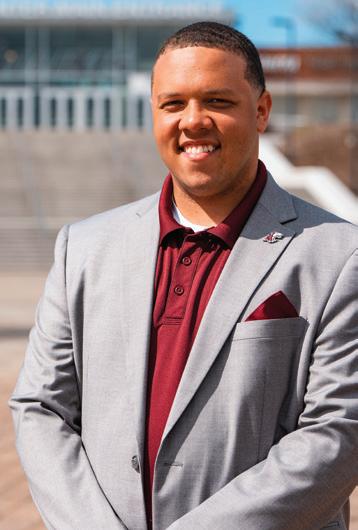
“You’re off to Great Places! Today is your day! Your mountain is waiting, So….get on your way!” - Dr. Seuss
opment. Though the future is still unfolding, Dylan’s focus remains clear: to serve, to lead, and to make a lasting impact. “I’ve put in the time and effort,” he says confidently, “and now it’s about finding the right opportunities to keep growing.”
Dylan Chambers is not just a notable alumnus of SIU; he is a shining example of what it
ASSOCIATION –
means to lead with purpose and passion. His journey from the high school halls of Metropolis to the corridors of municipal government, and then to the vibrant community of SIU, is proof of dedication, faith, and hard work. As he continues to forge his path, there’s no doubt that Dylan will remain a respected and influential figure, both in his hometown and beyond. Keep an eye on this vibrant young man, brimming with energy, ambition, and zest. He’s off to great places! Today is his day! His mountain is waiting, so... he’ll get on his way! Oh, the places he will go!
When hustle is rewarded:

Holly Stotlar learned one thing while attending Southern Illinois University: Few people can outwork her. What started as the hustle to keep on track for her education ended with her as the president and CEO of the family business, Karco, Inc., which today runs RollnUp Smoke Shop and Liquor with 12 locations throughout Southern Illinois.
Holly Stotlar’s work ethic at SIU lead to being a successful president and CEO of her family business. see the SIU Alumni Magazine Fall 2024 edition at HTTPS://SIUALUMNI.COM/ MOR E INFOR MATION

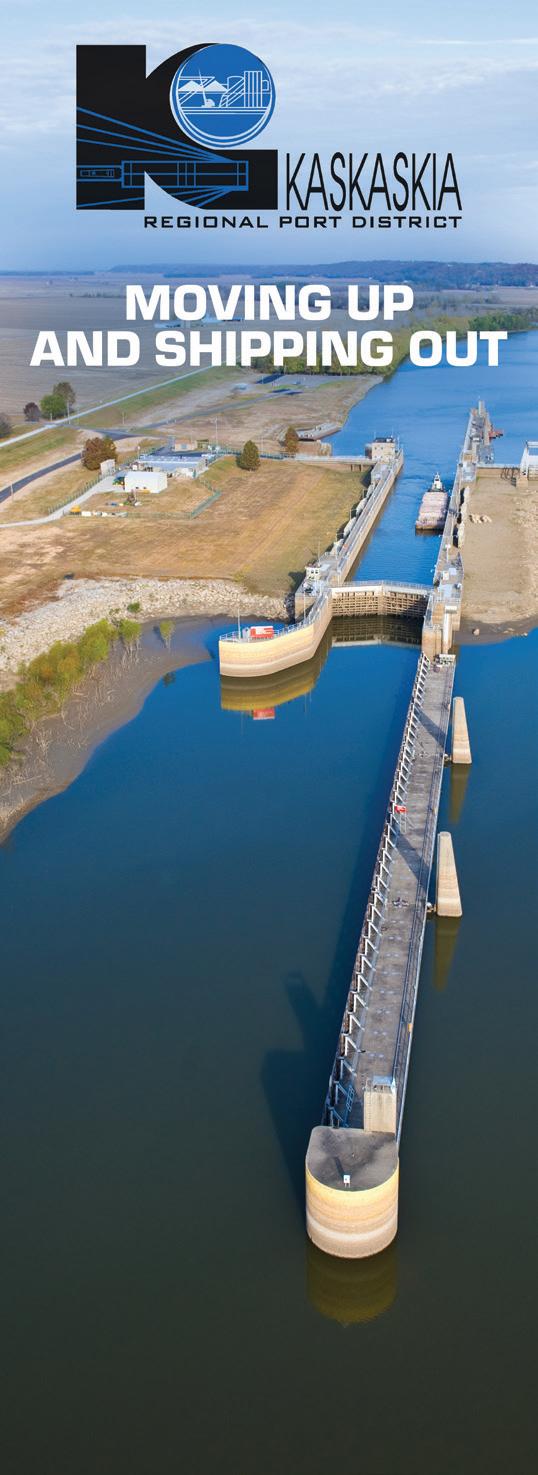
Alumni SPOTLIGHT:
Drs. Carl and Linda FlowersA Legacy of Inspiration and Impact
Southern Illinois University Carbondale (SIU) has a long-standing tradition of nurturing leaders who leave a lasting impact on their communities. Drs. Carl and Linda Flowers are prime examples, transforming from SIU students into community pillars, deeply committed to giving back the support and inspiration they received during their university years.
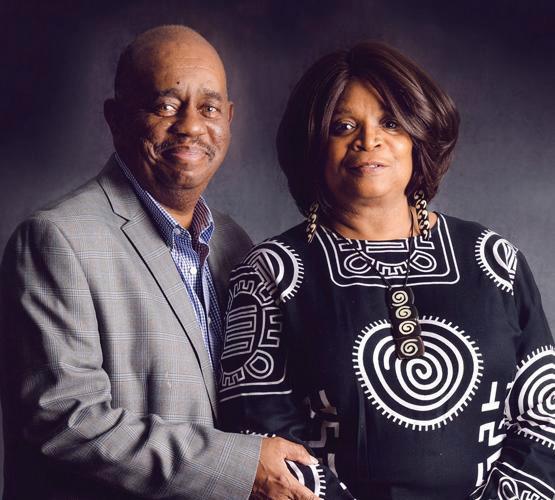
From Chicago and St. Louis to SIU Carbondale
Linda Flowers, the fifth of eleven children from Chicago, arrived at SIU with aspirations of becoming a teacher. Despite her high academic standing in high school, she quickly discovered that college posed new challenges. “Coming from a vocational high school in Chicago, I didn’t realize how much catching up I had to do,” she recalls. However, Linda found strength in SIU faculty members like Dr. Harold Bardo and Dr. Seymour Bryson, who recognized her potential and provided the support she needed. “They believed in me when I didn’t fully believe in myself,” she reflects, turning her initial struggles into a six-year journey of growth.
Carl Flowers, from St. Louis, arrived at SIU with a passion for journalism and quickly made his mark as the night editor for The Daily Egyptian. Choosing SIU over the University of Missouri, where most of his friends were headed, proved pivotal.
“
“ Choosing SIU changed everything for me,” Carl says. “It wasn’t just about the education; it was about the connections and the community I found here.
The connection between Carl and Linda blossomed in the most unlikely of places— the cafeteria at Trueblood Hall. “It started with a simple lunch together,” Carl recalls. Linda, skeptical of Carl’s smooth talk, wasn’t impressed. “I thought, ‘Yeah, right, here’s another guy with a line.’ But then he asked what my birthdate was, and when I told him, his eyes lit up. He told me he had the same birthdate! I made him show me his driver’s license. Even then, I joked that he probably had a driver’s license for every day of the year!” just to impress the girls.
Honoring a Legacy of Resilience
Throughout their time at SIU, the Flowers were keenly aware of the legacy left by Black students who had come before them. “When I think about the Black alumni who paved the way, I am filled with gratitude,” Linda says. Organizations like the Black Togetherness Organization and the Black Affairs Council provided crucial support and leadership training. The Flowers felt a profound sense of responsibility to continue this legacy, with Carl adding, “The work done by those before us laid the groundwork for everything we achieved.”
The Transformative Power of Greek Life
For Linda, joining a sorority was a turning point in her academic journey. “Before pledging, I’ll admit I wasn’t the most
dedicated student,” she says. But sorority life brought structure and accountability, leading to a transformation in her academic performance. “After I joined, I never got below a 3.0 GPA,” she proudly shares. Similarly, Carl found that fraternities and sororities at SIU were more than just social organizations—they were communities that fostered leadership and kept students focused on their goals.
Building a Legacy in Education
Inspired by the legacy of those before them, the Flowers focused on making their own impact. Linda pursued a career in special education, eventually becoming a principal in Carbondale. “I wanted to be a role model for students who looked like me and to make a difference in the lives of children,” she says. Her experiences at SIU, where she was often one of the few Black students in her education classes, deeply influenced her approach to leadership and advocacy.
Carl transitioned from retail management back to academia, earning his master’s and PhD at SIU. As the director of the Rehabilitation Institute in the College of Education and Human Services, Carl led the program to national acclaim. “My goal was to know every student by name and make sure they felt supported,” he explains, striving to offer the same kind of support that helped him succeed.
A Lifelong Commitment to SIU and the Community
Even after their careers flourished, the Flowers remained deeply connected to SIU and the Carbondale community. Carl, a passionate sports fan, regularly attends SIU games, while Linda enjoys the social aspects of tailgating and community events. But their involvement extends far beyond personal enjoyment. Linda has been active in the Black Alumni Group and the NAACP, leading efforts to secure grants for community initiatives. Carl’s expertise in grant writing has enabled projects that support voter registration, clean energy job recruitment, and more. “We’ve been fortunate to give back to a place that has given us so much,” Carl says.
In 2022, the Flowers were honored as the Grand Marshals of the Lights Fantastic Parade, a testament to their enduring influence on the Carbondale community. For them, this honor reflects the impact they’ve made, driven by the inspiration they received at SIU. “We’ve always felt a responsibility to give back, to make a difference,” Linda says.
For current SIU students, the Flowers offer this advice: “Keep your focus and work hard,” Carl advises. Linda adds, “Choose jobs that align with your passion, and listen to your professors—they have knowledge that can shape your future.”
Drs. Carl and Linda Flowers are more than just alumni—they are the embodiment of how the inspiration of others can fuel a lifelong commitment to making a difference. Their story is one of love, leadership, and a deep sense of responsibility to continue the legacy of those who paved the way, ensuring that the doors they walked through remain open for future generations.
VIENNA HIGH SCHOOL
Blazes the trail with career-connected programs
Student Testimonials
VHS Senior Aspires to Soar through the Sky

For as long as he can remember, Parker Trovillion has dreamed of being a pilot. With his sights set on soaring through the clouds, this Vienna High School senior isn’t wasting any time. Ever since he was a kid who was mesmerized by airplanes, Parker has dreamt of becoming a pilot. Now, thanks to the innovative aviation and drone program at Vienna High, that dream is taking flight. The program is proving to be the perfect launching pad for Parker’s ambitions, as it is equipping him with the knowledge and practical skills necessary to take flight after graduation. He plans to continue his journey by attending Southern Illinois University in Carbondale to attend their aviation school. He will be a few steps ahead of his peers, as he will already have 21 transcriptable credits that will go towards the program.
Full Circle: From Student to Educator

The Vienna Grade School (VGS) board of education recently selected one of their own to join their teaching staff. Ms. Maelee Sparks is a former Vienna Grade School graduate, who then graduated as valedictorian from Vienna High School in 2022. Ms. Sparks simultaneously graduated with her associates degree from Shawnee Community College. While attending Vienna High School, Ms. Sparks was a member and served as an officer of the school’s Educators Rising Club. She completed several observation hours in her education classes taught by Mrs. Leslie Bradley. Mrs. Bradley said the following, “It is so rewarding to see a student who completed the college and career education pathway at Vienna just a
short two years ago secure her first teaching job. Maelee was an excellent education student and is definitely prepared to meet the challenges and opportunities that come with being a first-year teacher.” Ms. Sparks conducted observations at Vienna Grade School under cooperating teachers Mrs. Elaney Spore (junior year) and Mrs. Tracy Trovillion (senior year).
In regard to joining the VGS team, Ms. Sparks shared,
“I am so very excited to be joining the Vienna Grade school family in 1st grade! While student teaching, I fell in love with teaching the littles, so I couldn’t be happier with this position! It is such an honor to be able to teach alongside so many of the teachers who helped shape me and inspire me to become a teacher.”
Principal Nicole Trovillion said, “Hiring Ms. Sparks is a win for Vienna Grade School! Her love for her community and her passion for teaching will exponentially serve the needs of students. Her drive and determination will make VGS better than ever before!”
Cradle-to-Career Pipeline: Reagan Johnson

Vienna is a pilot school for a federally funded program known as community schooling, and Ms. Reagan Johnson has been selected to serve as one of two program directors. Johnson is a 2020 graduate and valedictorian of Vienna High School. While in high school, she earned two associate degrees from Shawnee Community College with honors. Johnson then graduated from Murray State University with two bachelor’s degrees in social work and criminal justice. Recently, she earned her master’s degree in social work from the University of Kentucky (UK). Johnson served in the student services department as an intern last school year and as the lead for the Vienna REACH program.
As one of the directors of community schooling, Johnson will be responsible for fostering a learning environment beyond the classroom walls. Through collaboration with schools, families, and community organizations, she will cultivate partnerships that bring resources directly to students and their families. She will also organize clubs and out-ofschool time programs. Community schooling aims to build upon and continue creating a school environment where students feel supported, connected, and empowered to reach their full potential.
Johnson stated, “I’m thrilled and extremely honored to be stepping into this role. As a proud product of Vienna schools and a lifelong resident of this community, I’m deeply invested in its success. I am eager to build upon our strengths and continue to foster a collaborative environment where students, families, and community partners work together. I’m so excited to have the opportunity to continue working alongside everyone!”
“Reagan is an inspirational figure for us. She is one of the first examples of the cradle-to-career pipelines established here. It is my privilege to be able to work alongside her to reach every child in Johnson County,” said Phillip Hosfeldt, dean of system programs.
“Vienna’s participation in the community schooling opportunity in Illinois is a major win for our kids and families. Reagan Johnson heading up this new effort adds a layer that will undoubtedly ensure its success. While this is new territory for our school system, we have already been enjoying some benefits, such as establishing an after-school art program, afterschool STEM club, and numerous other supplemental opportunities that will be available to students and families,” said Joshua Stafford, school superintendent.
TESTIMONIALS PROVIDED BY VIENNA HIGH SCHOOL
MOR E INFOR MATION
about community schools can be found at: https://www.viennahighschool.com/page/ communityschooling

VIENNA, ILLINOIS
EXPANDING OPPORTUNITIES: The Regional Cultural & Vocational Center Vision
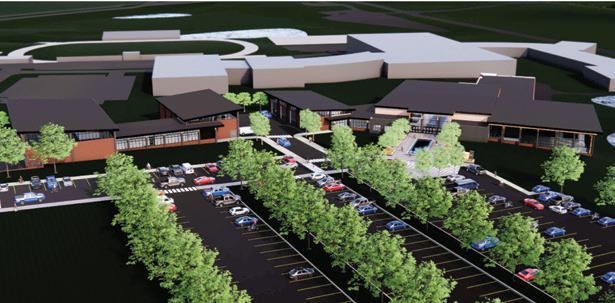
Southern Illinois, rich in history and culture, is confronting distinct challenges in workforce development and community engagement. As the region navigates economic disparities, a bold vision has emerged to tackle these issues directly: the establishment of a Regional Cultural & Vocational Center in Vienna. This center is designed to deliver essential career training and serve as a cultural and community hub. Led by Vienna High School administrator Phillip Hosfeldt, this project seeks to create a space where education, workforce development, and community engagement converge.
THE VISION
In Illinois, there are currently 26 regional vocational and technical centers designed to train high school students and adults in high-demand careers. However, Southern Illinois, particularly the lower southern counties, lacks such a facility. The closest existing center, the Southern Five Vocational Center in Tamms, primarily supports off-site Career and Technical Education (CTE) programs, leaving a significant gap in accessible, centralized training resources for the region.
The vision for a Regional Cultural & Vocational Center in Southern Illinois is comprehensive and far-reaching. The proposed center would offer training in essential fields such as nursing, early childhood education, culinary arts, and aviation mechanics—fields that are crucial to the region’s economic development but currently lack sufficient training opportunities for local students. By providing a physical location where these programs can thrive, the center aims to address both the immediate workforce needs of the region and the long-term goal of retaining talent in Southern Illinois.
MORE THAN JUST WORKFORCE DEVELOPMENT
One of the driving forces is the acute shortage of essential services in the region. As the Johnson County Early Childhood Coordinator,
Hosfeldt has an authentic passion for this kind of endeavor. He mentions, “In the entirety of Johnson County, we have one private daycare center (that can) only hold a maximum of 40 kids for all the kids zero through seven in the county. If it’s not a public preschool program through a school, there is nowhere else for our kids to go. So, I started trying to figure out a way to help facilitate the opening of more daycare centers in our area.” This shortage leaves many families without adequate childcare options. Hosfeldt’s proposal includes an early childhood education program within the vocational center, modeled after successful programs in other parts of the state, where high school students would gain practical experience while providing affordable childcare services to the community.
The center would also address other critical shortages, such as the lack of dental care facilities and cultural spaces. With only two dental offices in the county, a dental tech program could offer low-cost cleanings and screenings, benefiting both students and the wider community. Additionally, the center would serve as a cultural hub, providing a venue for community events, performances, the arts, and other gatherings—something that is currently missing in the area.
“This is not just a workforce issue for us in Southern Illinois. This center would be a cultural and community hub.” Hosfeldt states.
THE COMMUNITY AND STATE INVOLVEMENT: A COLLABORATIVE EFFORT
Bringing this vision to life will demand a unified effort from the entire Southern Illinois community, alongside backing from state legislators and economic development organizations. Hosfeldt stressed the need for regional visioning sessions, where stakeholders can collaborate to explore and fine-tune the concept of the vocational center. These discussions would help establish a consensus on the specific programs and services the center should provide, ensuring it effectively addresses the region’s needs.
OVERCOMING CHALLENGES
The path to establishing a Regional Cultural & Vocational Center in Southern Illinois is not without challenges. Hosfeldt identified several key obstacles. One of the main challenges is capacity. Currently, the project is being driven by a small team and expanding the capacity to advocate for and market the center will be crucial. Building a coalition of supporters who can help promote and advance the project is essential to its success.
Another obstacle to realizing this vision is funding. While the project has already secured a $50,000 Rebuild Illinois grant through the Illinois Arts Council for initial planning and concept design, the next step will require significant financial investment. Hosfeldt highlighted the role of organizations like SI Now and the Southern Illinois
Economic Development Council in advocating for the project and helping to secure the support of state legislators
Time is another significant concern. While CTE centers are currently in vogue, with state funding available for such projects, there is a sense of urgency. The fear is that if the region does not act quickly, the opportunity to secure funding and build the center could pass as priorities shift to other areas.
The location and scope of the center are also critical. Ensuring that the center is in a place that benefits the entire region, rather than just a single city, is vital. The goal is to create a truly regional center that serves the needs of all Southern Illinois residents, particularly those in rural areas who may lack access to similar resources.
Finally, building regional awareness and generating buy-in from the community and local leaders is essential. Without widespread support, the project may struggle to gain the necessary momentum to move forward.
TIMELINE FOR SUCCESS
Hosfeldt has set an ambitious timeline for the project. He hopes to move into the funding phase in two years, with construction beginning within five to seven years. Given the scope of the project, it will likely take two years from the start of construction to completion. By 2035, the goal is to have a fully operational regional vocational center that serves as both an educational facility and a community resource.
The center’s design is inspired by the Shawnee National Forest, with architectural elements that reflect the region’s natural beauty. This connection to the local environment is intended to make the center a place that resonates with the community—a space that feels like home and represents the region’s past, present, and future.
CONCLUSION: A VISION FOR SOUTHERN ILLINOIS
Guided by Phillip Hosfeldt, Vienna High School’s vision for a Regional Cultural & Vocational Center in Southern Illinois is both ambitious and essential. This center has the potential to address critical workforce gaps while providing vital community services, positioning it as a key driver of the region’s future growth. However, turning this vision into reality will require collaboration, commitment, and investment from all parts of the community. With the necessary support, this project could establish the groundwork for a brighter, more prosperous Southern Illinois, both economically and culturally.
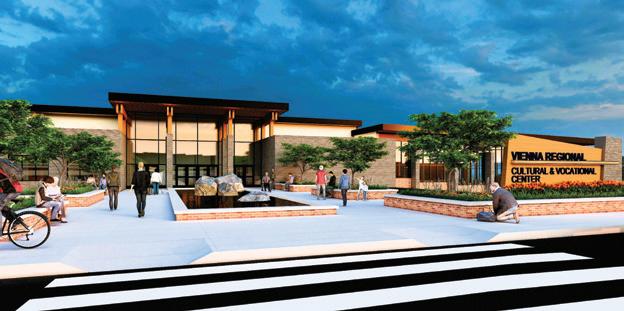


Visions of us





– PAUL ELLEDGE


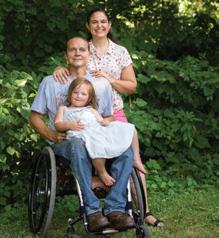
“Visions of Us: Southern Illinois Portraits” - An Exhibition Celebrating Diversity
During the Covid-19 pandemic, photographer Paul Elledge found himself reflecting on life amidst the widespread economic uncertainty and global unrest. Originally from Chicago, Elledge had also spent time in Southern Illinois, a region often stereotyped as being predominantly composed of farmers and coal miners. Determined to challenge and broaden this narrow perception, Elledge set out to highlight the rich diversity of the region through his art.
Elledge’s exhibition, “Visions of Us: Southern Illinois Portraits,” displayed the vibrant and varied lives of Southern Illinois residents. On display at the Cedarhurst Center for the Arts in Mt. Vernon, Illinois, until December 31, 2023, the exhibition aimed to celebrate the wide spectrum of individuals who contribute to the community’s unique tapestry like small businesses, artists, musicians, and workers. The show gained additional recognition through its feature on the PBS program “Exploring the Heartland.”
Inspired by the work of renowned and acclaimed photographer August Sander, Elledge sought to capture the depth and resilience of the people in Southern Illinois. He believes that fostering diversity within this “rainbow of humanity” can forge profound connections and drive meaningful change
As an alumnus of Southern Illinois University, Elledge described the process of creating the exhibition as emotionally moving. His approach to selecting subjects was both methodical and organic: he began with a diverse list of individuals and then expanded it through personal recommendations. This collaborative method allowed Elledge to create a comprehensive and inclusive representation of the community, shedding light on the multifaceted nature of Southern Illinois.
“Visions of Us: Southern Illinois Portraits” shows strength and diversity of the region’s inhabitants, challenging stereotypes and highlighting the rich cultural fabric that defines Southern Illinois.

SI NOW MAGAZINE FALL & WINTER HAPPENINGS: 2024-2025
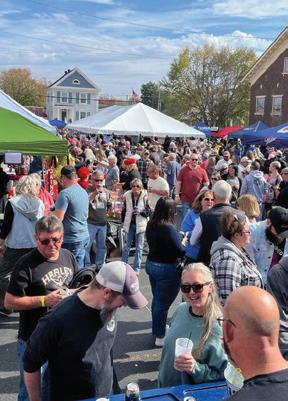


October
November
December
December
December
December
December
February
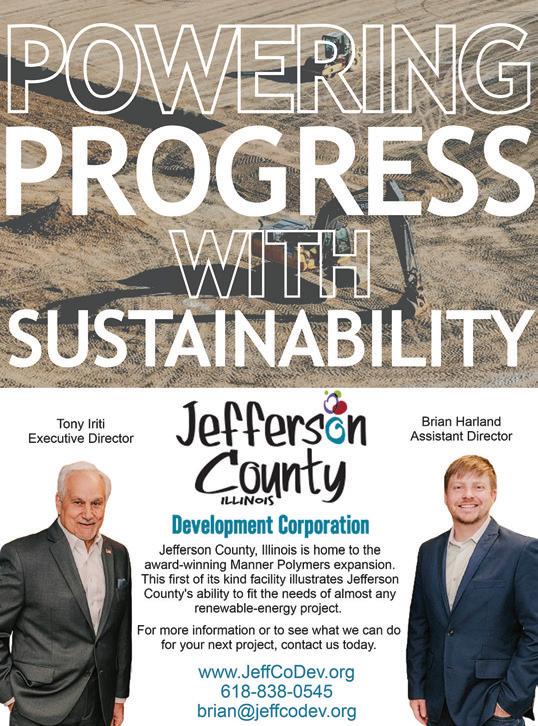




BUSINESS LEADER testimonials
Alyssa Connell MANAGER - SOUTHERN ILLINOIS AIRPORT
“Let me come to a place that lets me be me while also contributing to the greater picture. There is something that happens to you when you come to a place like this where people are so welcoming, and you get to explore who you are. The good people who are here are dedicated to making this the place that is welcome and home.”
Bill Cox
SENIOR VP OF ADMINISTRATION - AISIN
“Southern Illinois has really grown. It’s really become a prosperous place for business. And a great place for recreation and a place to raise a family.”
Celia Robertson
OWNER - HOUSE 2 HOME REALTY
“I think we take for granted all that we have to offer here. The lakes, the hills, the hiking, the fishing, the hunting, the wineries. Just the beauty of it all.”
Wes Perkins VICE PRESIDENT - CRUCIAL AVIATION
“When we go to recruit people or talk about things, the biggest thing I push is the cost of living. What you get in this area just blows away everything else that we can do with our competitors as far as where those stations are at. Our competitors are in the bigger markets, like the Miami’s, the Chicago’s, the Los Angeles’, and we can do the same kind of work on the same kind of aircraft that’s in an area that’s 40% cheaper to live, that’s our biggest selling point.”
Will Stephens MAYOR - CITY OF MURPHYSBORO
“We’ve got a lot of opportunity here and most of our communities like Murphysboro, like West Frankfort, like Carbondale, we’re ready to help and want to see people’s visions come to life.”
Deb Barnett EXECUTIVE DIRECTOR - SI NOW
“We have a lot of resources for businesses whether they’re looking to get started or expand. There are a lot of mentors around who have walked that road before you that are more than willing to help and we want to see each other succeed.”
Mike Monchino MONCHINO MANAGEMENT, LLC
“Southern Illinois has good schools for those that have children. Safety, our crime rates are relatively low compared to every other metropolitan area that you can find. Then we also have the outdoor activities. We have a beautiful area here. We have college sports with Southern Illinois University. And if you want professional sports, hop in your car and in two hours you’ll be in St. Louis.”
Austin Lane CHANCELLORSOUTHERN ILLINOIS UNIVERSITY
“If you want to relax, and free your mind, this is the place to do it. The University contributes to this live, work, play, and learn. Having all those things come together are incredible. Folks are focused on winning, not just maintaining, but winning.”


Align Wealth Management
Ameren Illinois
E. T. Simonds
Egyptian Electric Cooperative
First Bank and Trust of Murphysboro
Tri-County Electric Cooperative, Inc.
WLC Management Firm, LLC
Black Chamber of Commerce of Southern Illinois
Carbondale Chamber of Commerce
Carterville Chamber of Commerce
Herrin Chamber of Commerce
Jefferson County Chamber of Commerce
Marion Chamber of Commerce
Murphysboro Chamber of Commerce
Red Bud Chamber of Commerce
Saline County Chamber of Commerce
Sparta Chamber of Commerce
West Frankfort Chamber of Commerce
Want to support the work of SI Now? Contact Deb at director@southernillinoisnow.org for details about partnership options and benefits.
gallery PHOTO



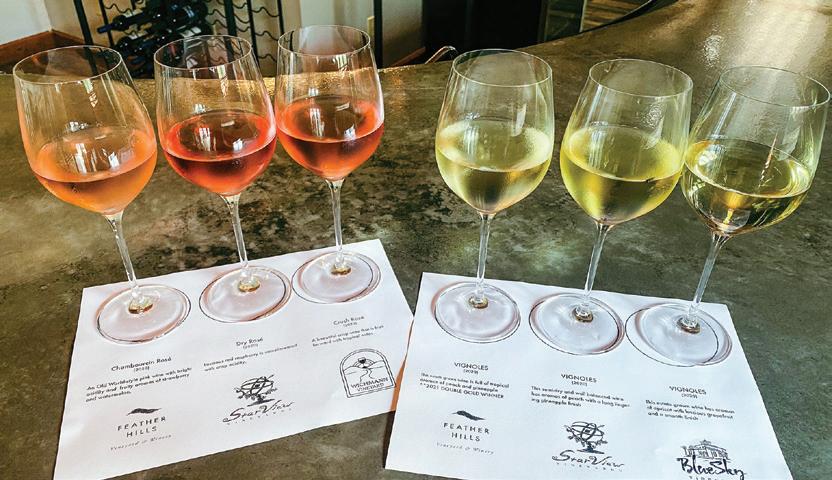










AWARDS AND recognition
SI Now (Regional Partnerships)
2024 International Economic Development Council Excellence Award


SI Now in Partnership with Arthur Agency (NOW! Magazine)
2024 International Economic Development Council Excellence Award

City of Marion (STAR Bond District)
2024 Business Facilities EDO Award
Montgomery’s Place (Carterville) and Havisham House (Alto Pass)
2024 Landmarks Illinois Richard H. Driehaus Foundation Preservation Award

Jefferson County Development Corporation (Manner Polymers Project)
2024 Site Selectors Guild Projects with a Purpose Award

Top 15 Trade and Industry Magazine Community Impact Award

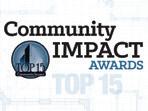
Gilster-Mary Lee (Steeleville)
First Spectrum Certified® Employer in the Nation

Gilster-Mary Lee Corporation becomes first-ever Spectrum Certified® Employer, celebrates National Disability Employment Awareness Month and Manufacturing Month – Sun Times News Online

Shawnee Bluffs Canopy Tour (Makanda)
Bloomberg TV’s World’s Greatest
Number of Busine sses
total es tablishment s 7319
SI Now region added 63 businesses
Q4 2022 to Q4 2023 Avera
$49,987 PER YE AR
20%
160,720
Helping Employers Prepare, Train & Retain
t
t
t



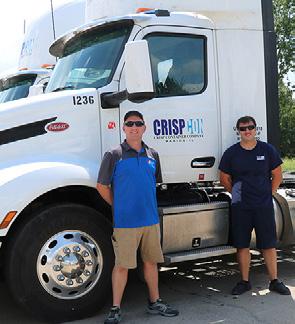



& Grow Your Company











Banterra is one of the nation's largest community banks and we are proudly based in beautiful Southern Illinois.
We began as a small bank in Ridgway, Illinois in 1975. Today, we have banking centers in six states, from small towns to large cities like Scottsdale, St. Louis and Salt Lake City. We have more than 500 team members and 40+ locations, with 25 of those around almost every curve in Southern Illinois - from Mt. Vernon to Metropolis.

With more than $3 billion in assets, lending capacity of $80 million, and vast experience with commercial and small business lending, we're proud to support economic development throughout our footprint and particularly in the region we call home. Contact us today to learn more about our nancial services and why Southern Illinois is the perfect place for your business.

Photo courtesy of @do.soill. Follow their Instagram page for Southern Illinois tourism offerings.
Ferne Clyffe State Park Goreville, IL COMMUNITIES
